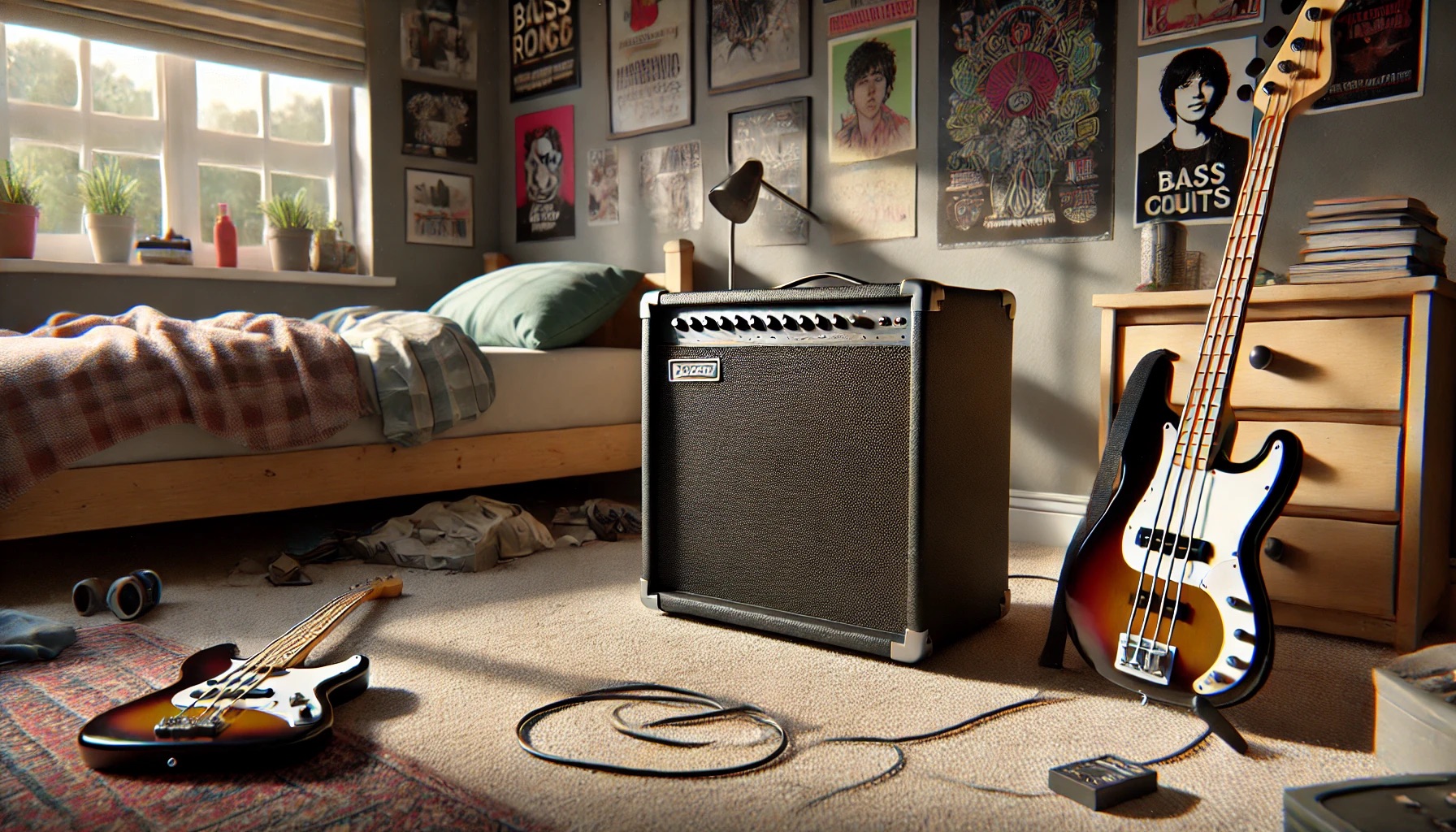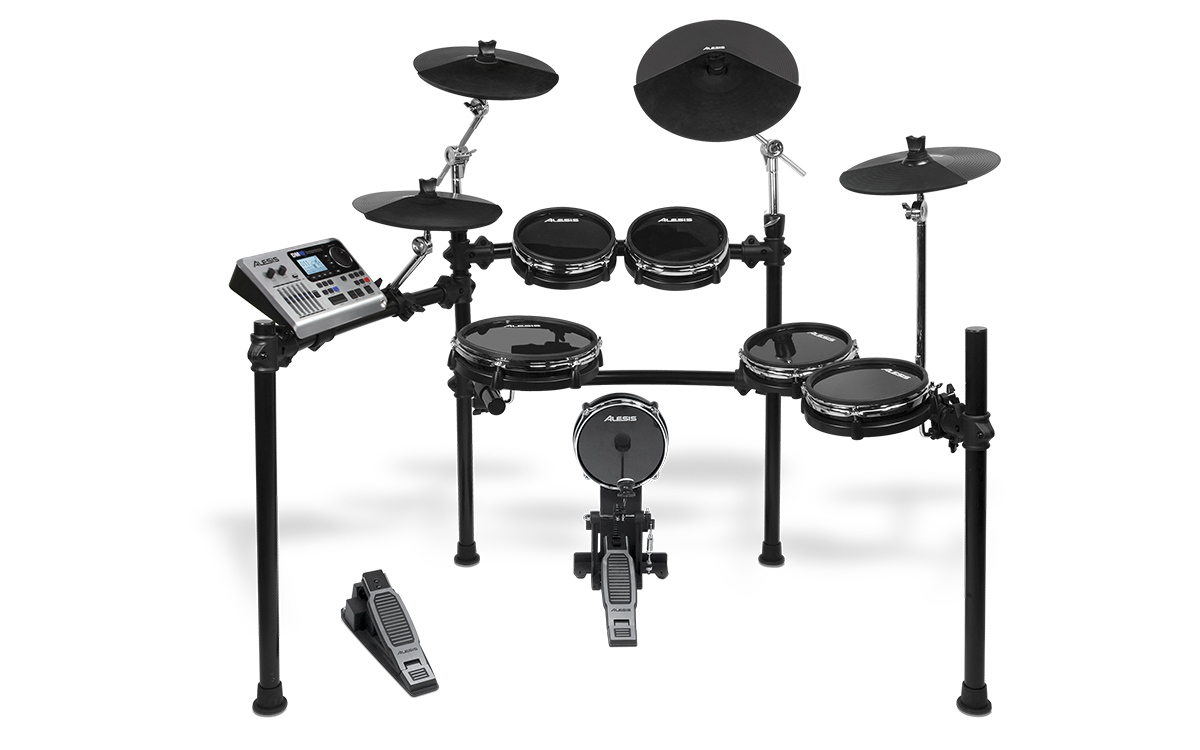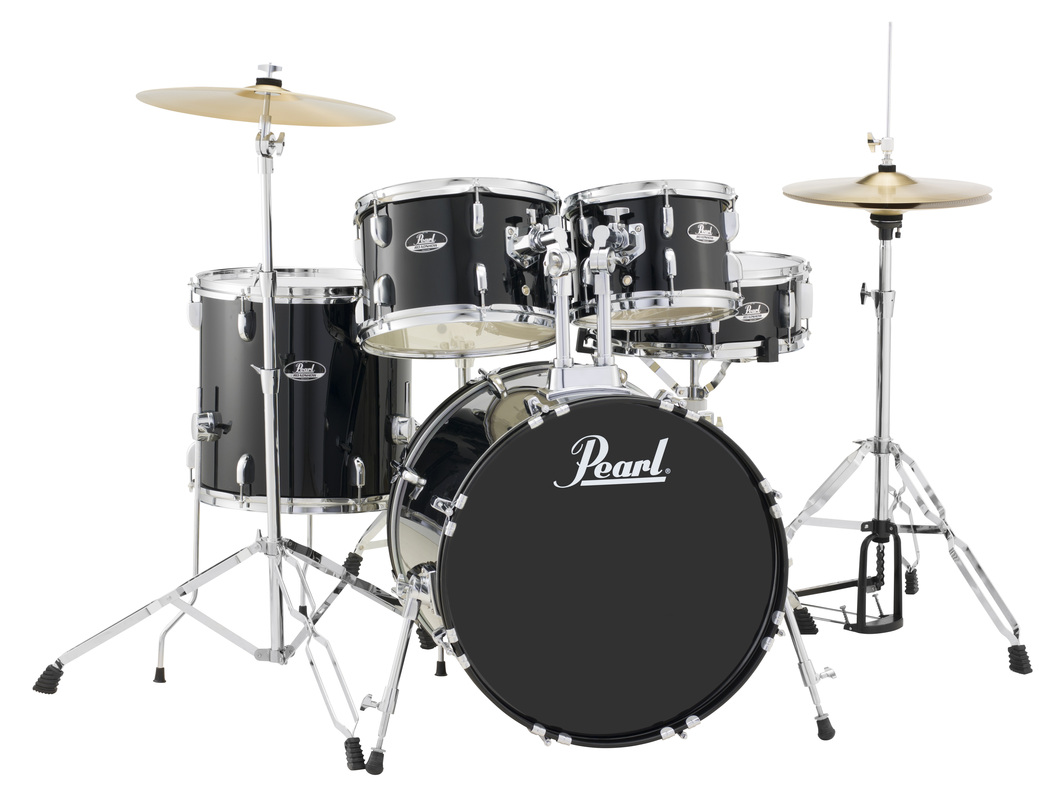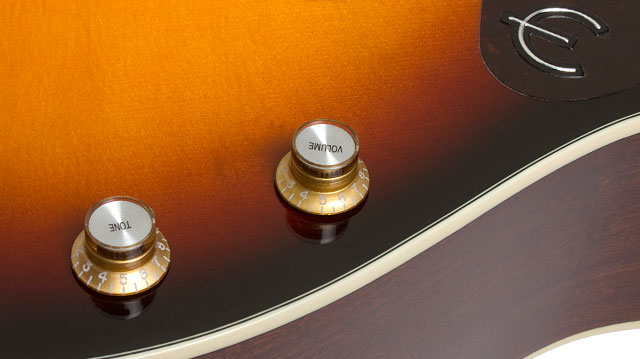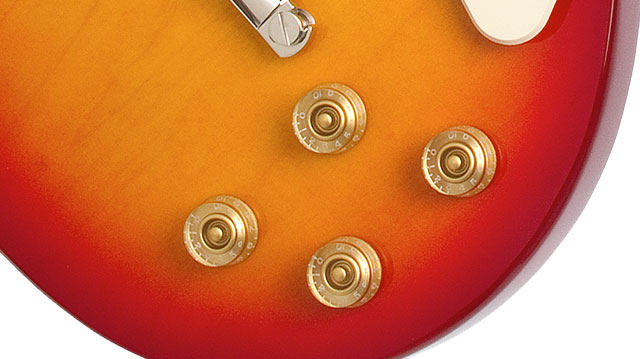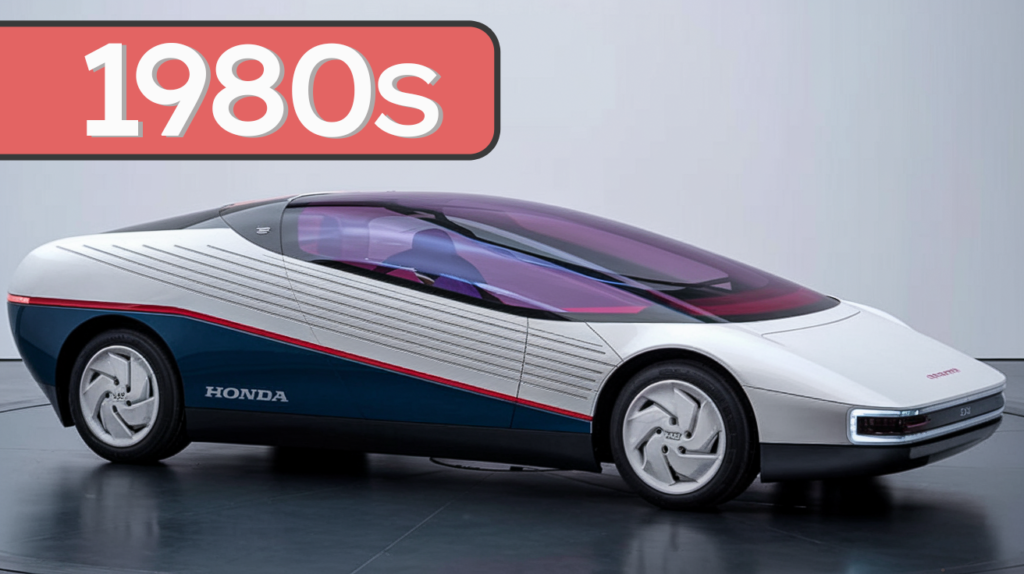
Have you seen these forgotten concept cars from the 1980s? These bold prototypes shaped the cars we drive today. Some pioneered aerodynamic designs that cut through air like knives. Others tested new technologies decades before they reached production. Many influenced vehicle shapes we now take for granted.
Today’s electric vehicles and digital dashboards began as radical ideas on drawing boards.
20. 1989 Pontiac Stinger (Exterior)

The 1989 Pontiac Stinger’s exterior shouted for attention with its radioactive neon green paint that made it impossible to overlook. This beach buggy concept featured a rugged off-road stance supported by oversized tires and a raised suspension system designed for all-terrain adventures. Its open-air design eliminated conventional doors in favor of easy access, while modular body panels could be reconfigured for different activities. The front featured distinctive rectangular headlights and a utilitarian brush guard that emphasized its go-anywhere capability, while the rear incorporated a minimalist approach with exposed components showcasing its recreational focus.
1989 Pontiac Stinger (Interior)
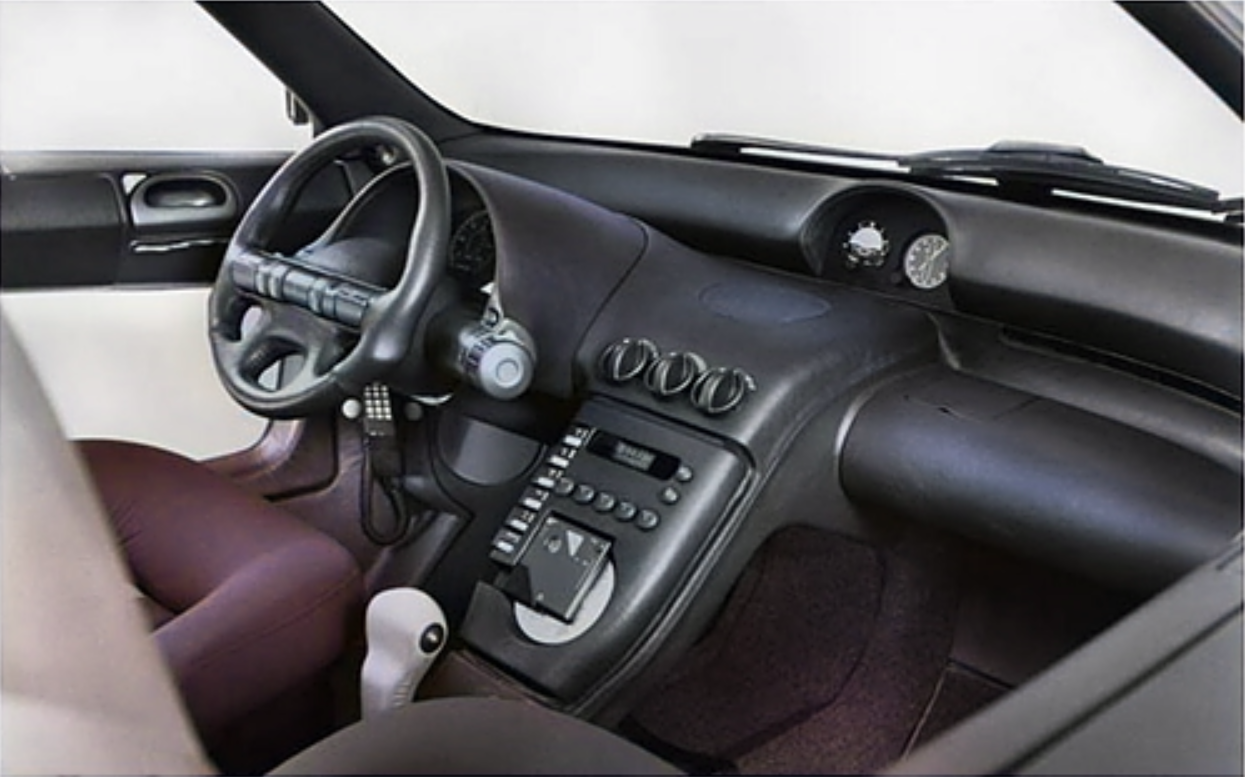
Inside the Stinger, Pontiac designers created a utilitarian yet futuristic space that prioritized versatility over luxury. The cabin featured water-resistant materials throughout, with removable seats that could be repositioned outside the vehicle for beach or campsite lounging. A modular dashboard housed basic instrumentation and a removable AM/FM stereo that could function as a portable sound system. Storage solutions dominated the interior design with 16 separate storage compartments including a built-in cooler, removable tool kit, and even a handheld vacuum cleaner. The Stinger’s interior epitomized functional design with weatherproof switches and drainage holes in the floor allowing occupants to hose down the entire cabin after a day at the beach.
19. 1987 Oldsmobile Aerotech (Exterior)
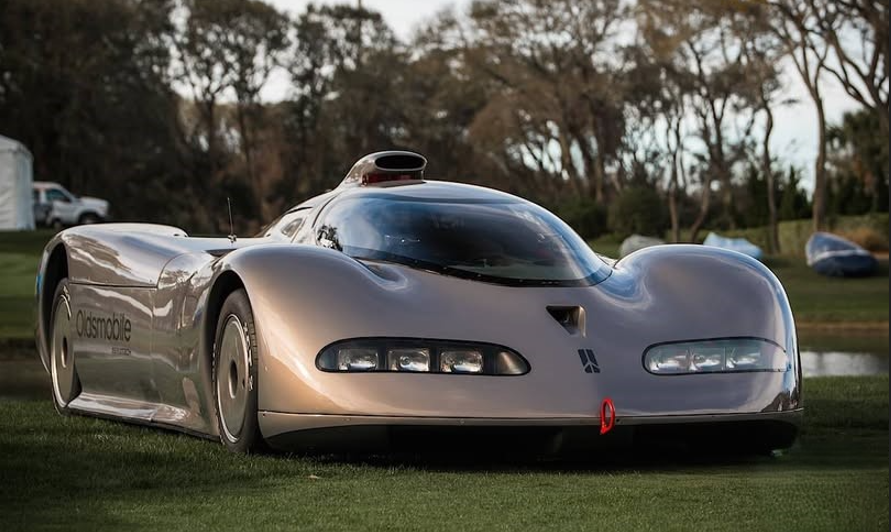
The 1987 Oldsmobile Aerotech’s exterior represented pure aerodynamic function, with every curve and surface designed to minimize drag. Its teardrop silhouette featured a dramatically low nose, smooth underbody, and extended tail section that worked together to achieve remarkable aerodynamic efficiency. Engineers eliminated traditional drag-producing elements, covering the wheels with streamlined panels and incorporating flush glass surfaces throughout. The canopy-style cockpit resembled a fighter jet more than a typical automobile, with a single-piece transparent cover that tilted forward for entry. At just 19 inches tall at its highest point, the Aerotech’s extreme low-profile stance visually communicated its singular purpose of cutting through air with minimal resistance.
1987 Oldsmobile Aerotech (Interior)
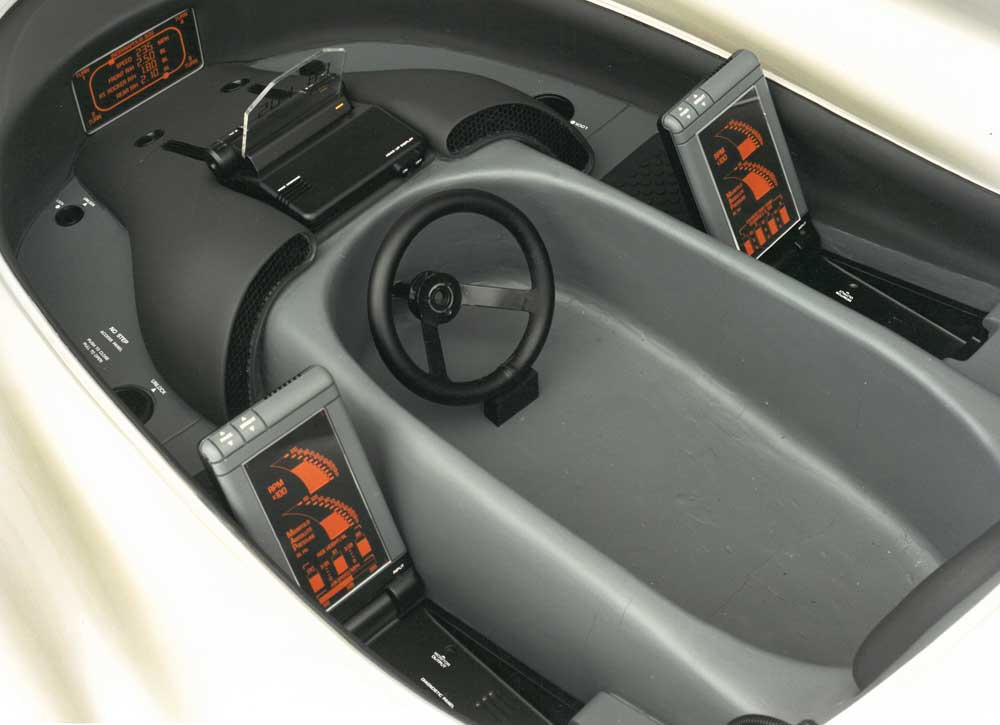
The Aerotech’s interior was equally purpose-built, featuring a minimalist single-seat cockpit designed around the driver like a racing prototype. A comprehensive array of analog gauges dominated the instrument panel, providing critical information about engine performance, temperatures, and pressures necessary for high-speed record attempts. The driver sat in a competition-grade racing seat with a five-point harness, surrounded by a protective roll cage integrated into the chassis structure. Climate control was basic but functional, focused on keeping the driver comfortable during high-speed runs where cockpit temperatures could rise significantly. The steering wheel featured a flattened bottom section for easier ingress/egress, while the manual shifter was positioned optimally for quick gear changes during acceleration.
18. 1980 Citroen Karin (Exterior)
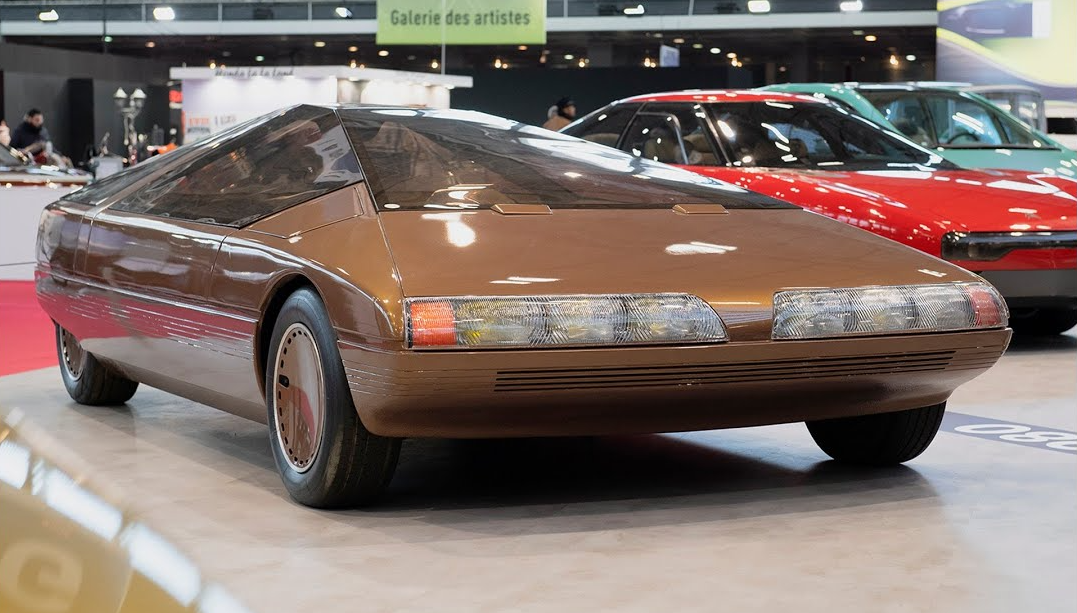
The 1980 Citroen Karin’s exterior broke fundamental design conventions with its striking pyramidal silhouette that narrowed toward the roof. This mathematical approach to automotive design created a triangular footprint with a wider base tapering to a slim greenhouse. The body featured sharp creases and flat planes rather than conventional curves, giving it an architectural quality rarely seen in automotive design. Its distinctive front end incorporated recessed headlights behind clear covers, while the rear featured an equally geometric treatment with triangular taillights. The most dramatic element was the greenhouse – a narrow, pyramid-shaped glass canopy providing excellent visibility while maintaining the concept’s geometric purity.
1980 Citroen Karin (Interior)
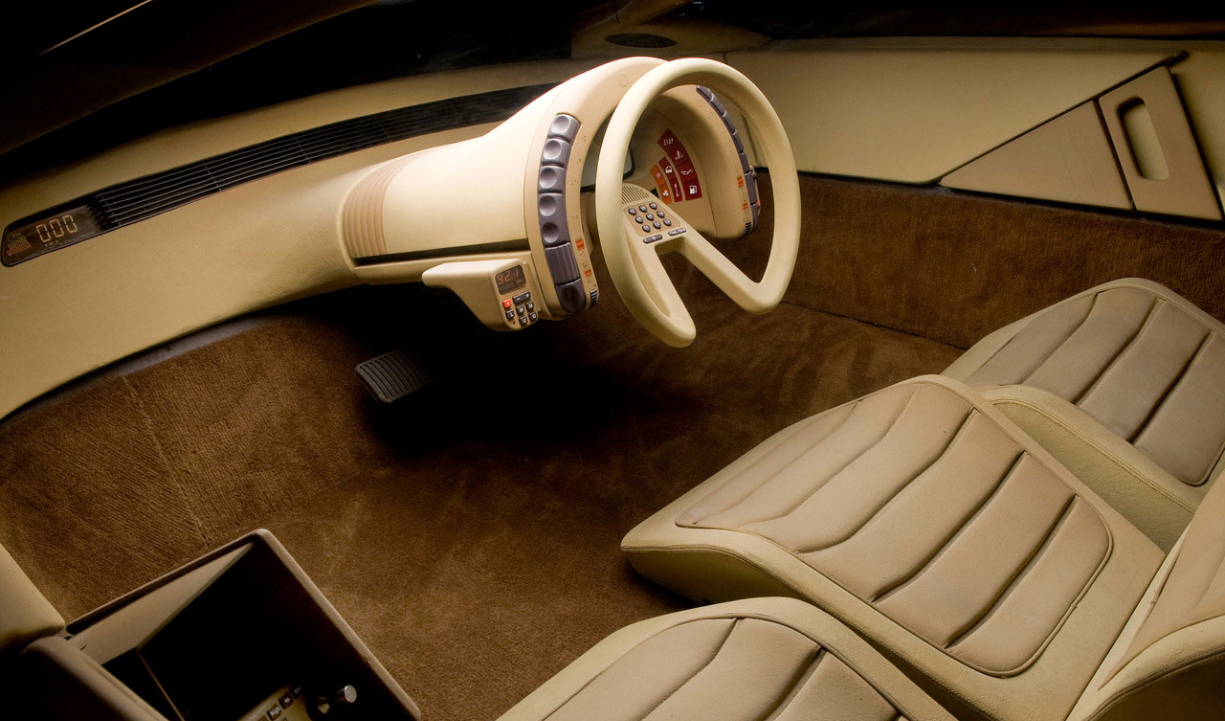
Inside the Karin, Citroen created an equally revolutionary three-seat arrangement with the driver positioned centrally and slightly forward of two passengers. This aircraft-inspired cockpit concept placed all controls within easy reach of the driver through an innovative satellite control system that positioned essential functions on pods extending from the dashboard. Instrumentation was entirely digital – advanced for 1980 – with early LCD displays providing vehicle information in a clean, modern format. The triangular theme continued throughout the interior with geometric seat designs and angular door panels that followed the exterior’s mathematical precision. Climate controls were incorporated into the central driver’s pod, allowing full environmental control without reaching across the cockpit.
17. 1984 Ford Maya (Exterior)
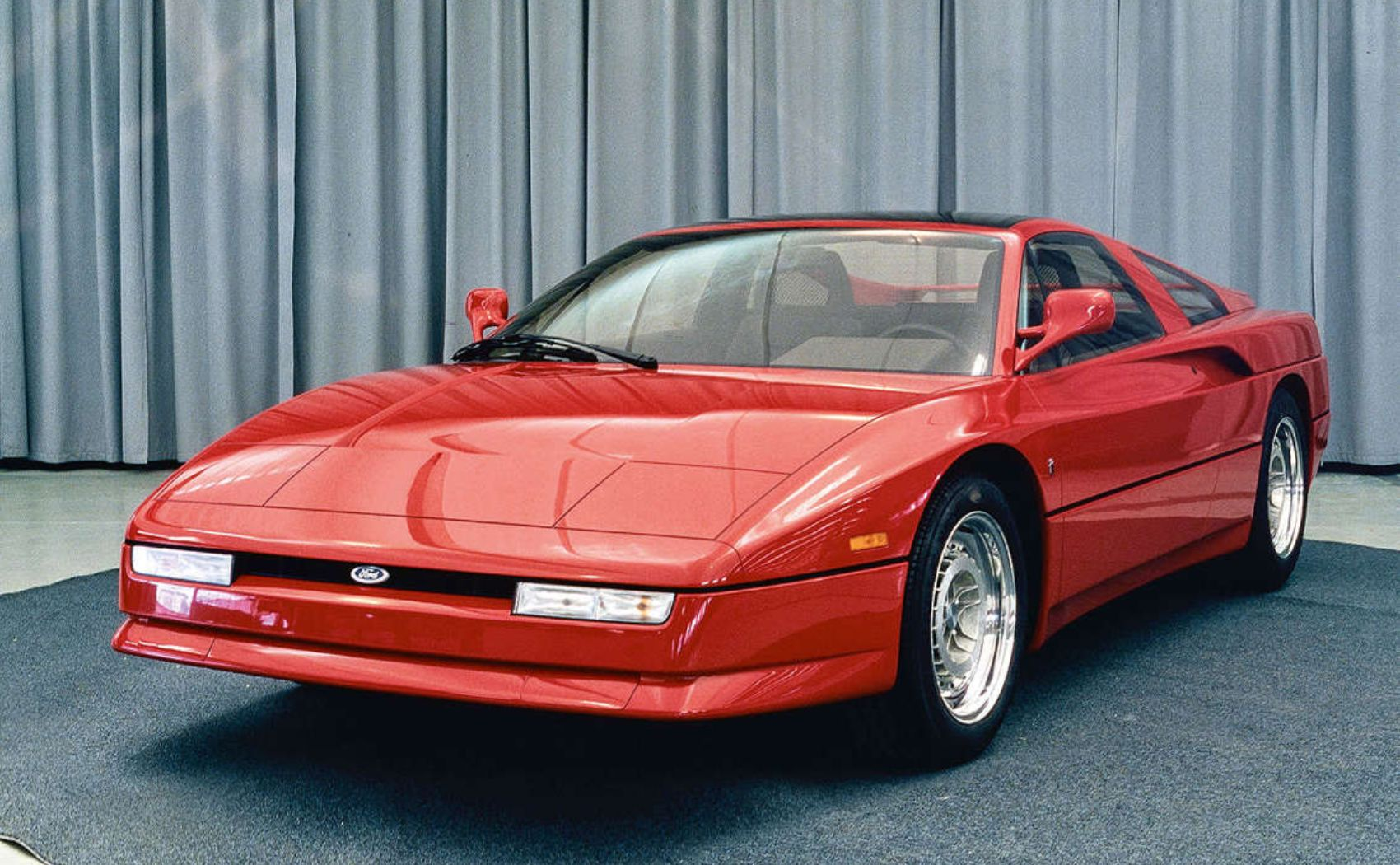
The 1984 Ford Maya‘s exterior combined sharp Italian styling with functional performance elements to create a distinctive sports car profile. Giugiaro’s design featured knife-edge creases, a wedge-shaped silhouette, and precisely defined surfaces that captured changing light in dramatic ways. The front incorporated pop-up headlights – a sports car signature of the era – while the rear featured horizontal slats over the engine compartment reminiscent of contemporary Ferraris. Its most distinctive design elements were the dramatically carved side intakes that channeled cooling air to the mid-mounted engine while creating visual excitement along the profile. Large wheels with minimal overhangs emphasized the purpose-built sports car proportions that set it apart from conventional Ford products.
1984 Ford Maya (Interior)
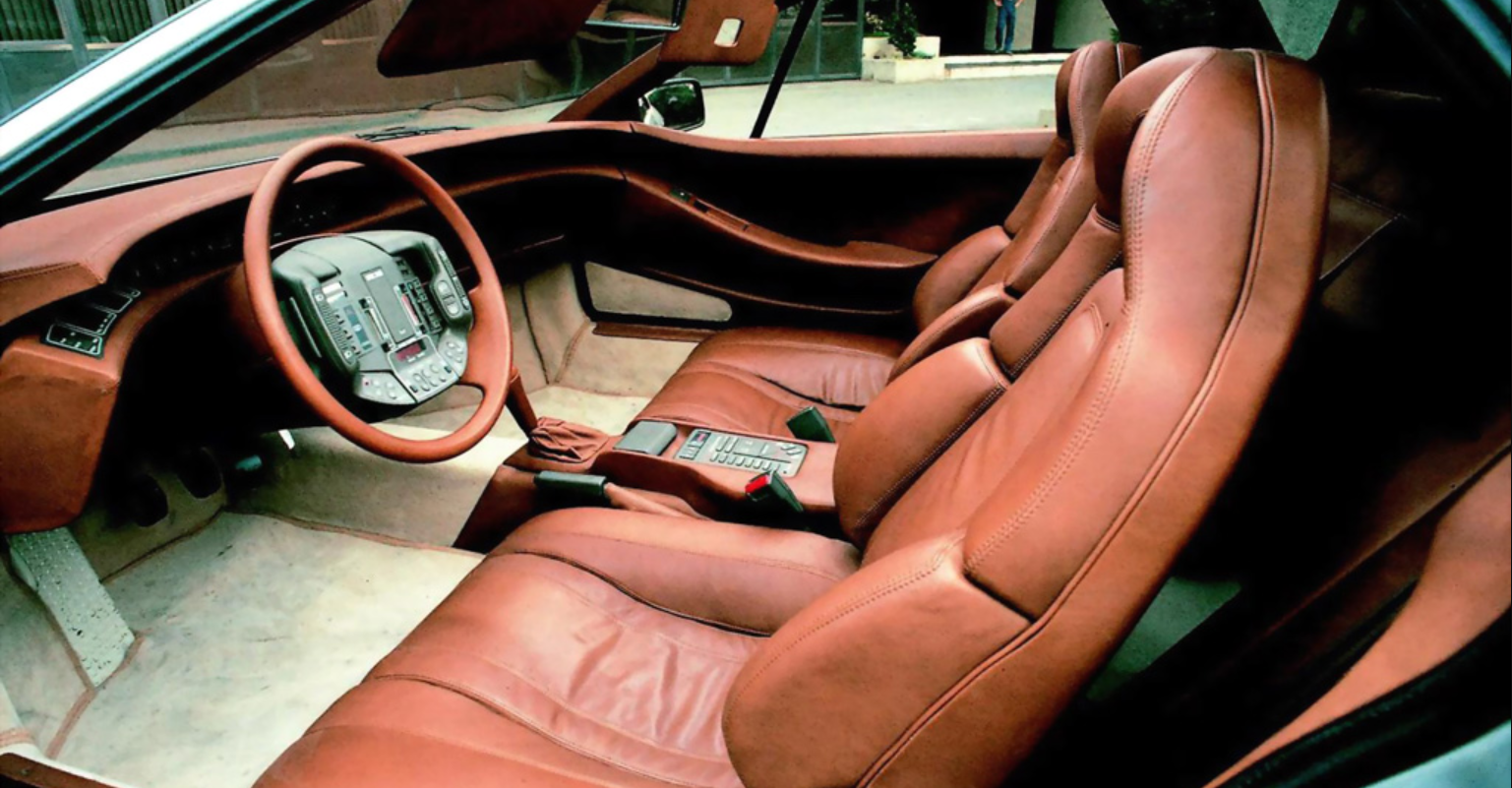
The Maya’s interior reflected Giugiaro’s approach to driver-focused design with a cockpit that wrapped around the occupants in Italian sports car tradition. The dashboard featured a driver-angled center console that placed all controls within easy reach, while instrumentation was comprehensive with large analog gauges prioritizing engine function and performance metrics. Seating consisted of deeply bolstered racing-inspired buckets finished in fine leather with contrast stitching – a premium touch that elevated the concept beyond typical American sports cars of the period. The steering wheel featured a small-diameter leather-wrapped rim with thumb grips positioned for spirited driving, while the manual shifter was topped with a machined aluminum knob for precise gear selection. Ford and Italdesign balanced luxury with performance focus throughout the interior, creating a space that promised driving excitement without sacrificing comfort.
16. 1980 Lamborghini Athon (Exterior)
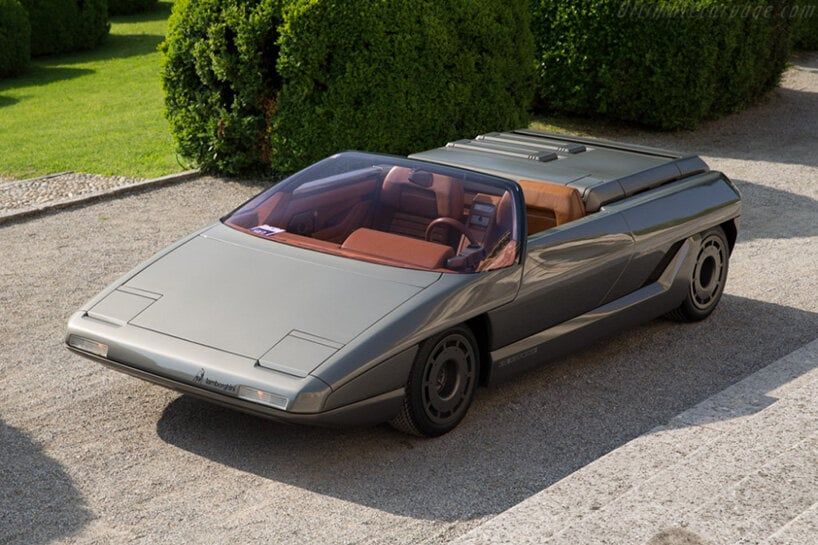
The 1980 Lamborghini Athon’s exterior embodied Bertone’s extreme wedge-shaped design philosophy with knife-edge surfaces that appeared to be carved from a solid block. Its incredibly low front profile rose gradually toward a squared-off rear deck in an uninterrupted line, while side windows were minimal angular slits that maintained the concept’s dramatic proportions. The front featured retractable headlights that disappeared completely into the bodywork, preserving the clean lines when not in use. Perhaps most distinctive was the completely flat windshield that met the hood at a radical angle, creating a continuous plane that enhanced the concept’s futuristic appearance. The rear incorporated horizontal cooling slats and minimalist taillights integrated into a clean, blade-like edge.
1980 Lamborghini Athon (Interior)

Inside the Athon, Bertone created an open-air cockpit that balanced functional sports car ergonomics with futuristic design elements. The dashboard featured a horizontal emphasis with rectangular digital displays – advanced technology for 1980 – displaying essential information in a clean, modern format. Seating consisted of angular bucket seats upholstered in beige leather with hexagonal perforation patterns that added visual interest while providing ventilation. The steering wheel featured an asymmetrical design with a flattened lower section and incorporated essential driver controls into the hub. Most distinctive was the center console that rose from the floor in a continuous plane, integrating the shifter and secondary controls into a sculptural element that complemented the exterior’s geometric precision. Despite the concept’s radical exterior, the interior remained reasonably practical with proper ergonomics suited for genuine performance driving.
15. 1986 Italdesign Machimoto (Exterior)
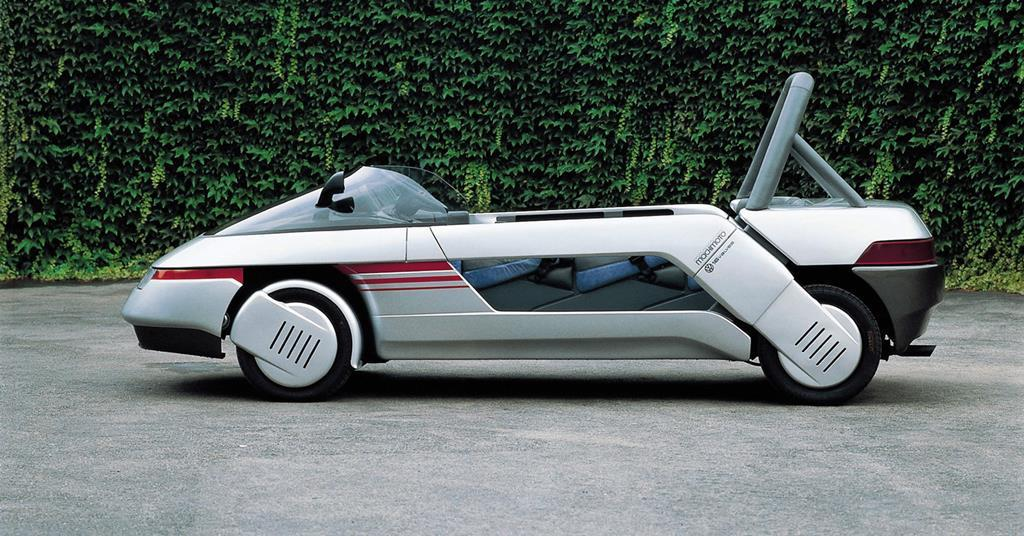
The 1986 Italdesign Machimoto’s exterior defied conventional vehicle categories with its open-sided body structure built on a modified Volkswagen Golf platform. The front maintained recognizable Volkswagen design elements with circular headlights and a simplified grille, while the profile revealed its unique configuration with a completely open passenger compartment lacking doors or side panels. A windshield provided minimal protection from the elements, while a roll bar structure extended across the top of the vehicle, providing safety and structural rigidity. The rear maintained a conventional hatchback-style cargo area, creating an unusual hybrid between practical transportation and recreational vehicle that looked like nothing else on the road.
1986 Italdesign Machimoto (Interior)
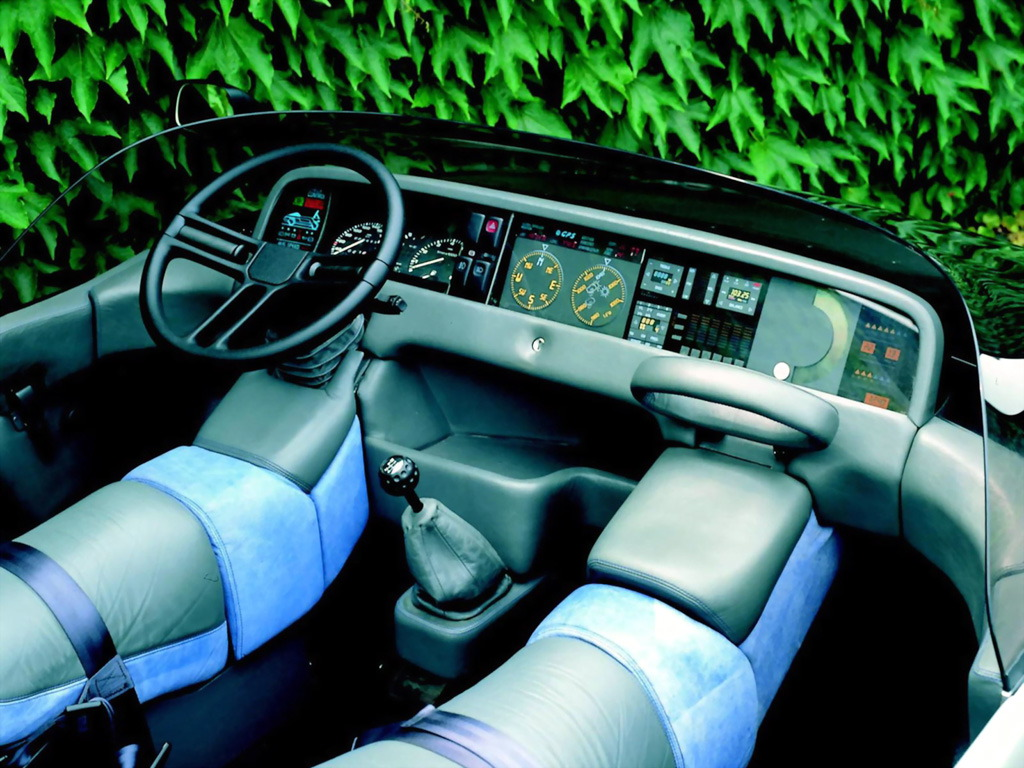
The Machimoto’s interior represented its most revolutionary aspect, replacing conventional automotive seating with six motorcycle-style saddle seats arranged in three rows of two. Each position featured a motorcycle-inspired seat with handgrips for passengers to hold during travel, creating an experience that blended car stability with motorcycle openness. Riders straddled these seats motorcycle-style, wearing standard safety belts attached to the frame structure for protection. The driver’s position maintained conventional automotive controls with a steering wheel, pedals, and instrument panel derived from Volkswagen components but reconfigured for the concept’s unique layout. Storage compartments were incorporated beneath several passenger seats, providing limited cargo capacity for personal items. Weather protection was minimal by design, with the concept intended for fair-weather recreational use rather than practical daily transportation.
14. 1984 Bertone Ramarro Corvette (Exterior)
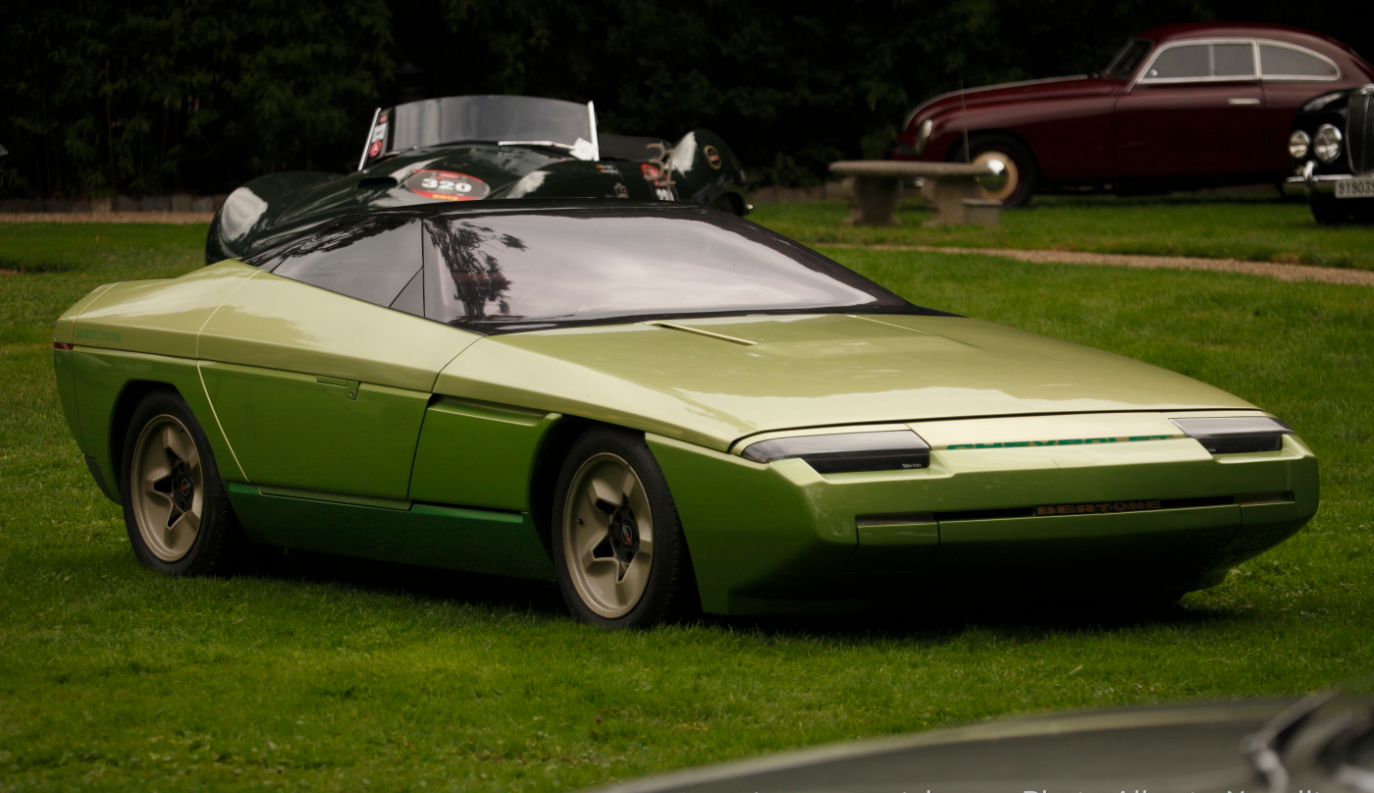
The 1984 Bertone Ramarro Corvette’s exterior reimagined American performance with Italian sophistication while maintaining the C4 Corvette’s mechanical foundation. Bertone’s design replaced every body panel with a sleeker, more aerodynamic interpretation featuring dramatically sliding doors that moved forward along the body sides rather than swinging outward. The front incorporated concealed headlights behind smooth panels that enhanced aerodynamic performance, while the greenhouse featured a more steeply raked windshield and expansive glass roof that improved visibility and interior ambiance. Its bright green exterior finish – inspiring the “green lizard” name – covered a body that was 10 inches shorter than the standard Corvette despite using the identical wheelbase, a feat achieved by repositioning radiators to the rear and reconfiguring mechanical components.
1984 Bertone Ramarro Corvette (Interior)
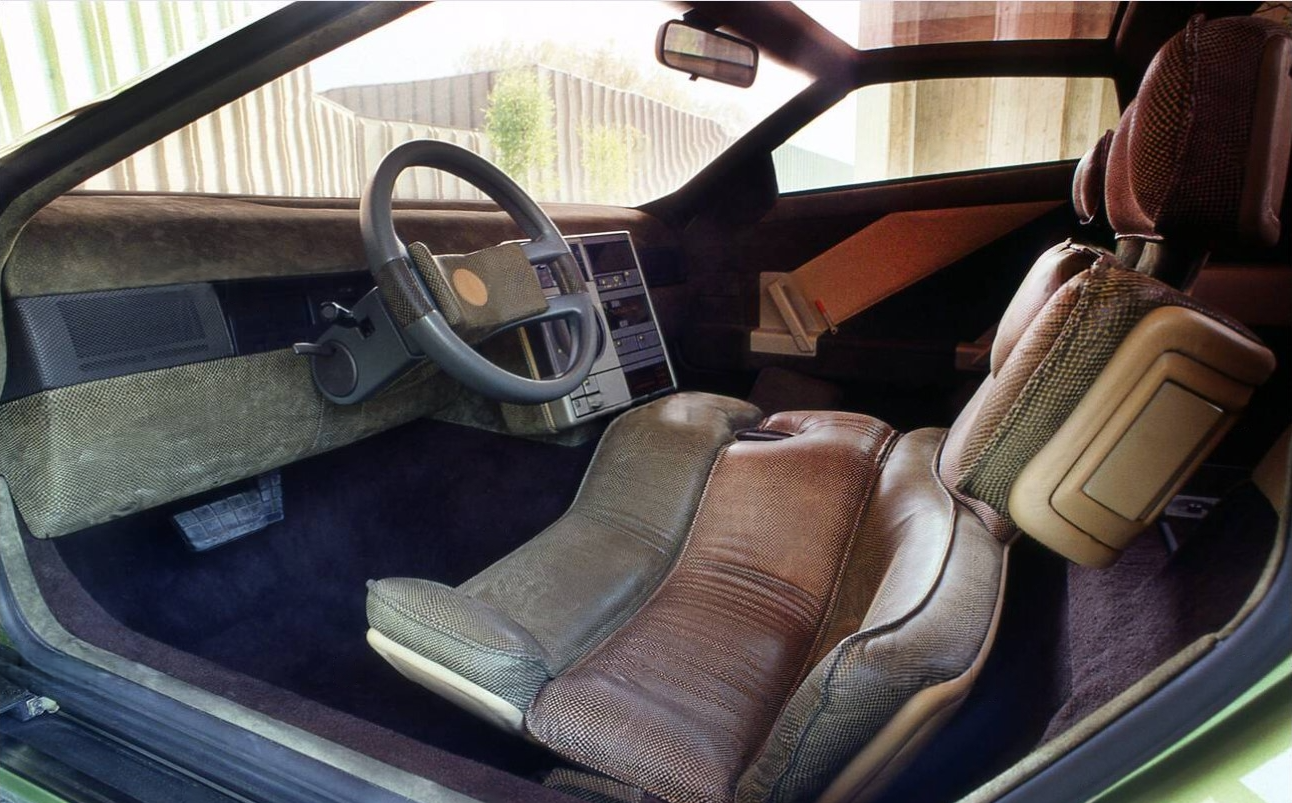
Inside the Ramarro, Bertone maintained the Corvette’s driver-focused layout while elevating materials and design details to European luxury standards. The dashboard incorporated the C4’s digital instrumentation but surrounded it with more premium soft-touch materials and refined detailing that added sophistication. The center console maintained essential Corvette controls but integrated them into a more sculptural design that flowed seamlessly into the dashboard. Door panels featured unique designs necessitated by the sliding door mechanism, incorporating distinctive grab handles and control placements that differentiated the concept from its production counterpart. Climate control vents were redesigned with rectangular outlets that better complemented the interior’s geometric theme while maintaining full functionality. If you’re a big fan of muscle cars, then these nine from the 1980s might be interesting to read through.
13. 1981 Citroen Xenia (Exterior)
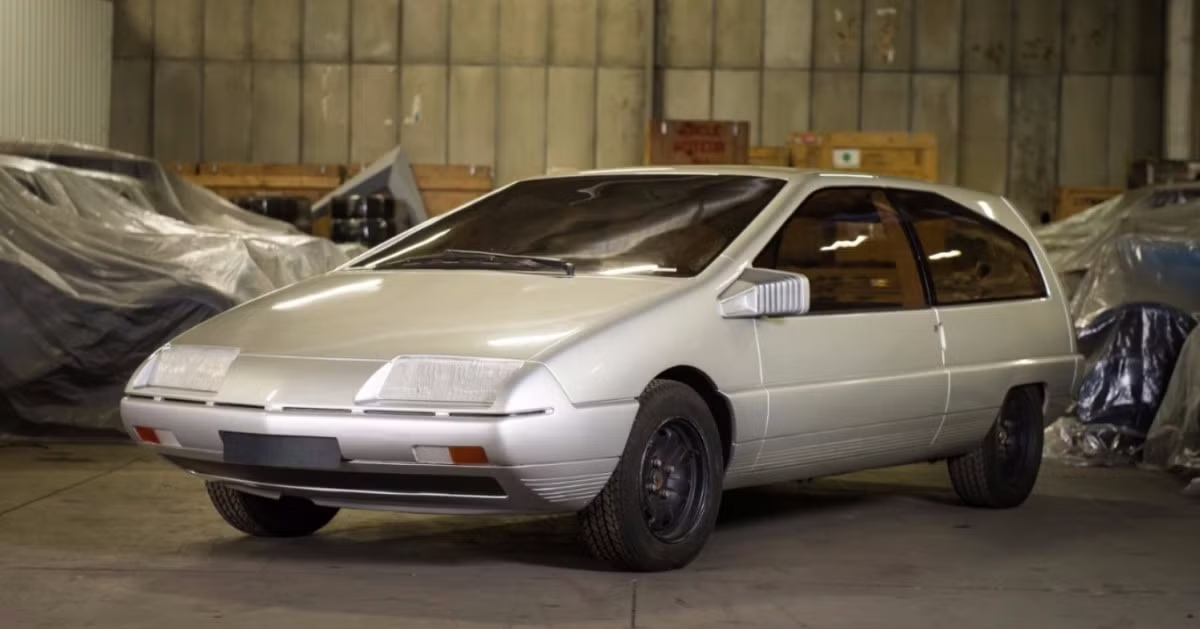
The 1981 Citroen Xenia’s exterior anticipated the minivan revolution with its tall, one-box design that maximized interior space within a compact footprint. Smooth aerodynamic surfacing minimized drag while large glass areas, including an expansive windshield and greenhouse, created an airy, open feeling. The front featured characteristic Citroen design elements with sleek, integrated headlights and a minimalist grille treatment. Its most innovative features were the sliding rear doors on both sides – years before this would become standard on production minivans – providing superior access to the rear seats. The rear incorporated a large, practical hatch that opened to reveal a flexible cargo area, emphasizing the concept’s focus on versatility and family functionality.
1981 Citroen Xenia (Interior)

The Xenia’s interior showcased Citroen’s innovative approach to space utilization with a reconfigurable cabin designed to maximize passenger comfort and cargo flexibility. Seating consisted of thin-profile bucket seats that maximized legroom while maintaining comfort, with rear seats that could fold or be removed entirely to create additional cargo space. Large side windows and a panoramic glass roof created exceptional visibility and an open feeling throughout the cabin. The steering wheel incorporated Citroen’s single-spoke design tradition, while secondary controls were grouped logically in pods according to function. Storage solutions abounded throughout the interior with numerous compartments integrated into door panels, the center console, and overhead areas – practical touches that would later become standard in production minivans.
12. 1980 Aston Martin Bulldog (Exterior)
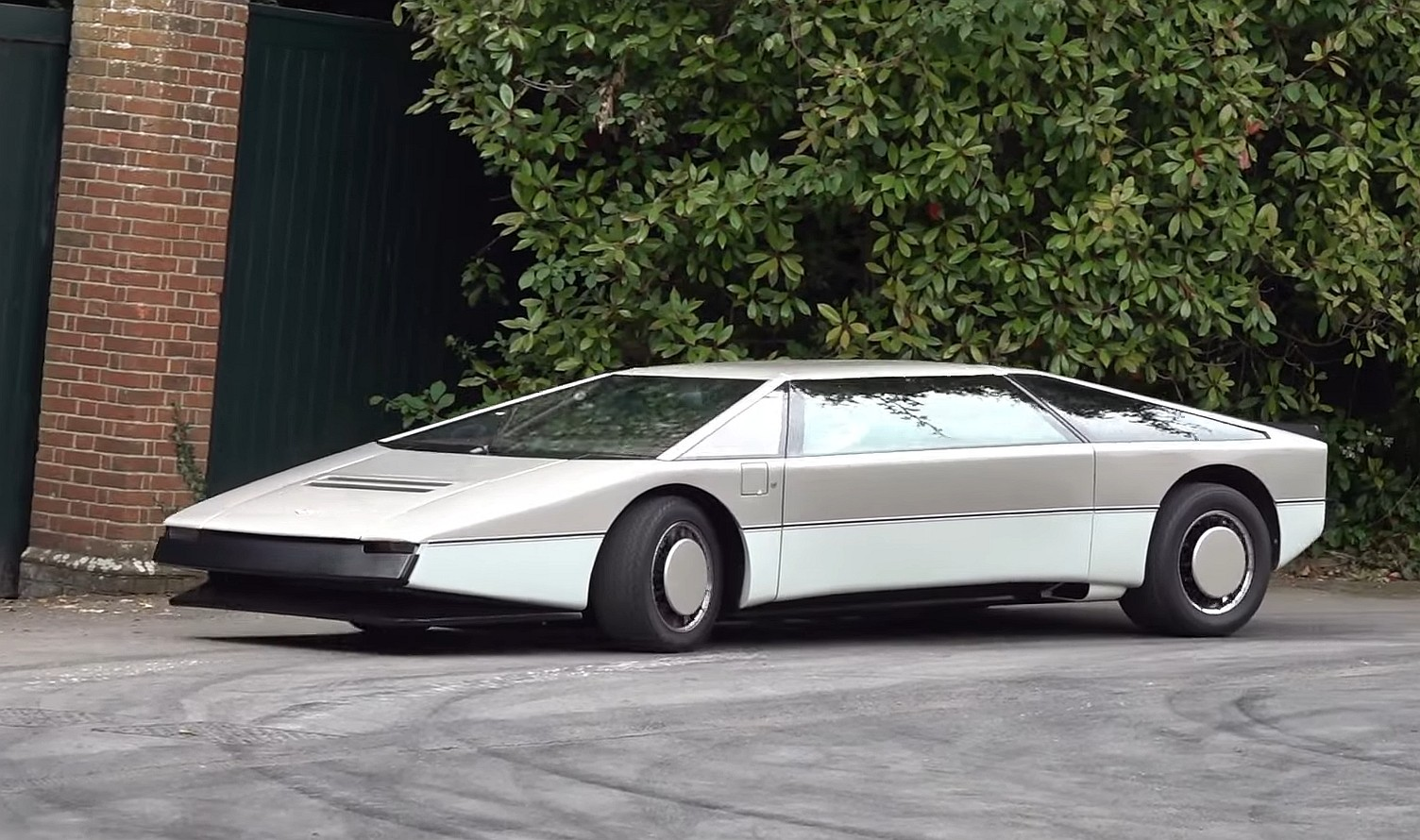
The 1980 Aston Martin Bulldog’s exterior exemplified the extreme wedge-shaped design trend with its dramatically low profile and sharp-edged geometry. Standing just 43 inches tall, the Bulldog featured a brutally geometric silhouette with a knife-edge front leading to a broad, flat rear deck. Five hidden headlights rotated from horizontal to vertical positions when activated, creating a distinctive lighting signature that contributed to the concept’s futuristic appearance. Its most dramatic elements were the massive gullwing doors that opened upward to reveal the entire interior cabin, necessitating portions of the roof to lift along with the doors.
1980 Aston Martin Bulldog (Interior)
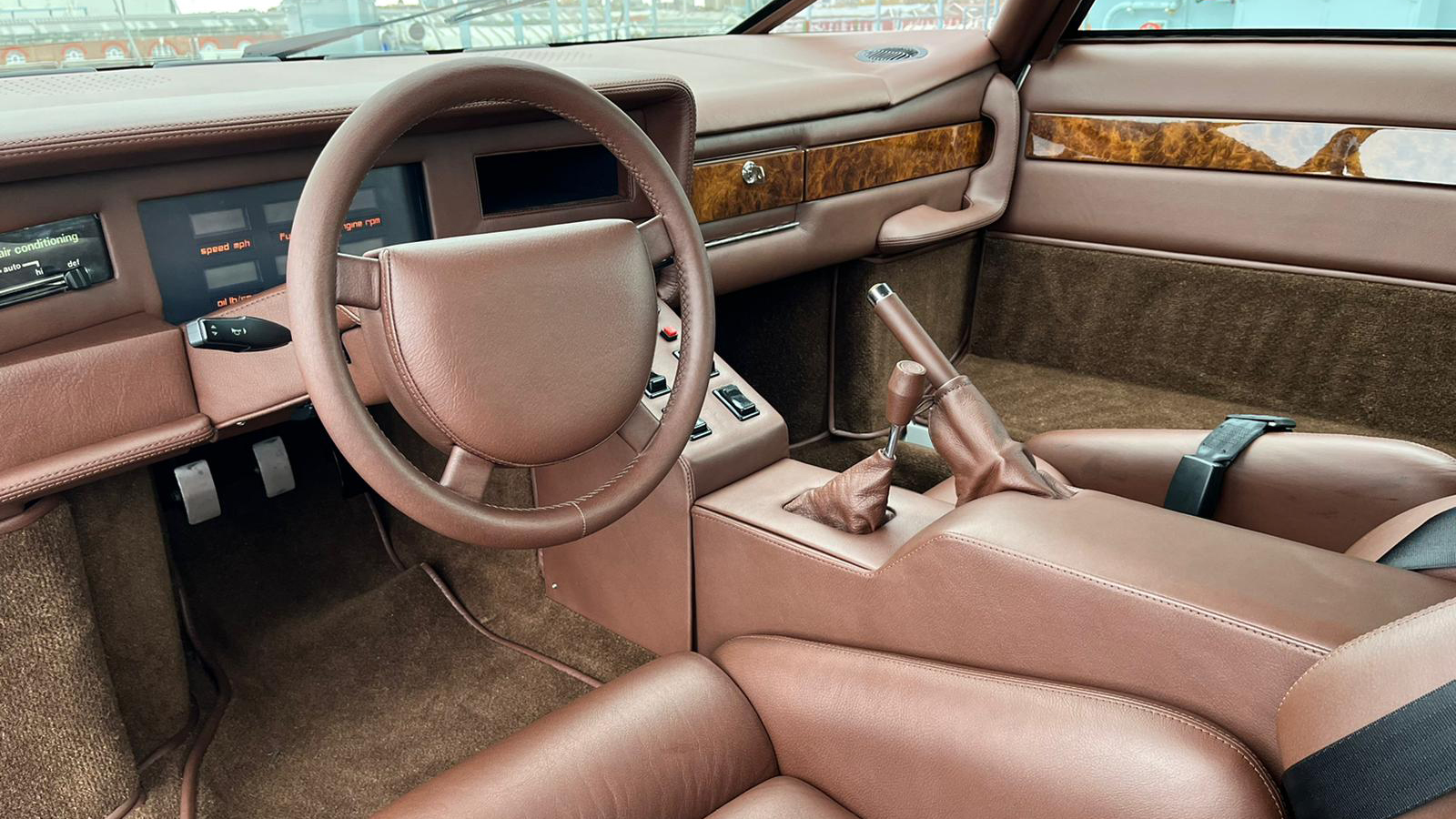
Inside the Bulldog, Aston Martin created a luxurious cabin that balanced performance focus with traditional British craftsmanship. The dashboard featured a combination of digital and analog displays – advanced technology for 1980 – set into a leather-wrapped panel that extended the full width of the interior. Tan leather upholstery covered the seats and door panels, creating a warm contrast to the concept’s angular exterior and providing a suitable environment for high-speed touring. The center console featured a distinctive leather-wrapped transmission selector and secondary controls positioned for easy driver access. LED displays provided additional vehicle information, incorporating technology rarely seen in automotive applications of the period.
11. 1983 Nissan NX-21 (Exterior)
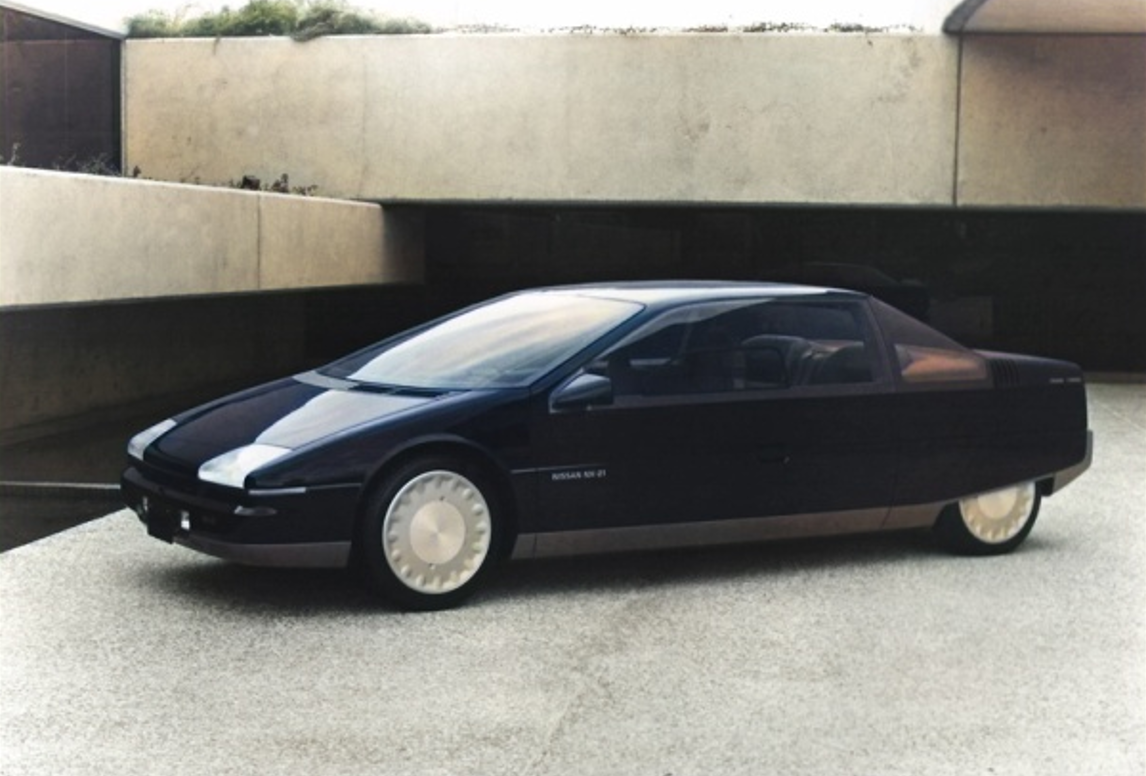
The 1983 Nissan NX-21’s exterior featured beautifully balanced proportions with smooth, flowing surfaces that predicted the move away from angular designs that would come later in the decade. Its aerodynamic profile incorporated flush glass surfaces, minimal panel gaps, and integrated bumpers that enhanced both visual continuity and wind-cheating performance. The front featured slim, horizontal headlights flanking a minimal grille opening – reflective of the reduced cooling needs of its gas turbine engine. Its most dramatic elements were the split gullwing doors that opened from both the roof and lower body sections, providing extraordinary access to the interior.
1983 Nissan NX-21 (Interior)
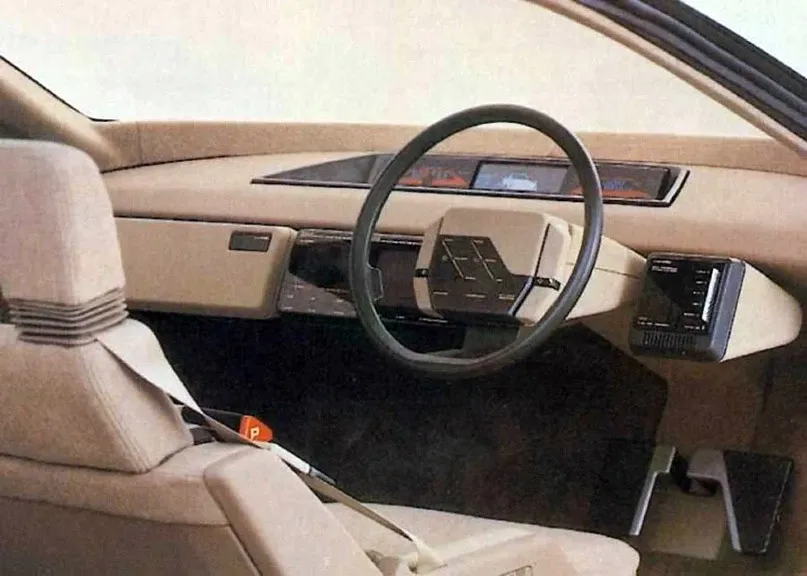
The NX-21’s interior showcased Nissan’s vision of future automotive technology with a comprehensive digital dashboard replacing conventional analog instrumentation. Multiple LCD screens displayed vehicle information in a configurable format – remarkably advanced for 1983 – while touch-sensitive controls eliminated physical buttons for a cleaner aesthetic. Seating consisted of four individual bucket seats with integrated headrests, upholstered in a technical fabric that combined durability with a futuristic appearance. The steering wheel incorporated an early multifunction control system with integrated buttons for essential features, allowing drivers to adjust vehicle settings without removing their hands from the wheel.
10. 1983 Buick Questor (Exterior)
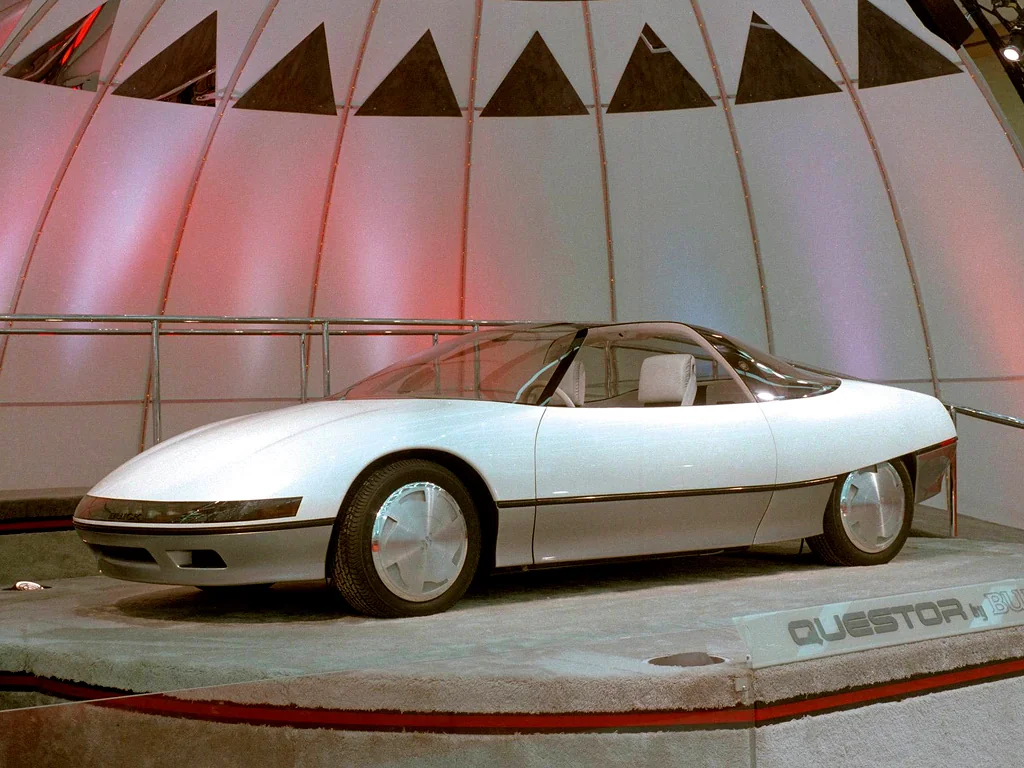
The 1983 Buick Questor’s exterior broke from General Motors’ traditional boxy design language with smooth, aerodynamic surfaces that minimized drag while creating a distinctive visual identity. Its sleek profile featured flush glass, minimal panel gaps, and integrated bumpers that flowed seamlessly into the body contours. The front incorporated slim, horizontal headlights and a minimal grille opening that emphasized the clean design while maintaining brand recognition through subtle Buick styling cues. Wheels were partially covered by aerodynamic panels that reduced turbulence while creating a futuristic appearance.
1983 Buick Questor (Interior)
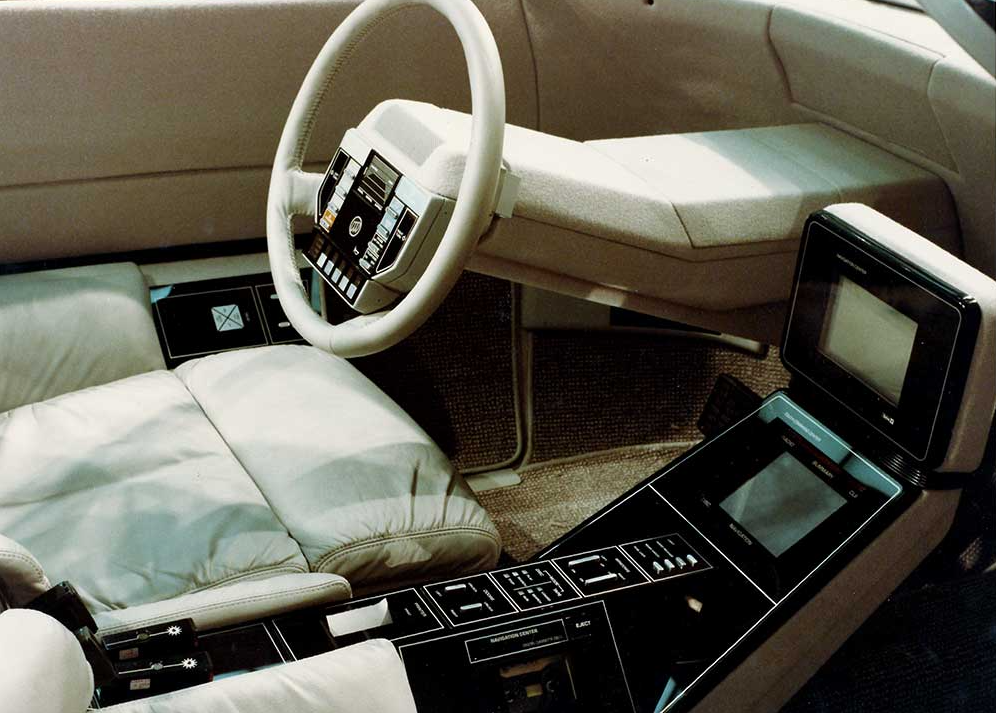
The Questor’s interior showcased General Motors’ vision of future automotive technology with a comprehensive electronic interface replacing conventional controls. A CRT screen – advanced technology for 1983 – displayed vehicle information and system status in a digital format, eliminating traditional analog gauges. Touch-sensitive controls and voice recognition technology allowed drivers to adjust vehicle settings through multiple input methods, demonstrating GM’s forward-thinking approach to human-machine interaction. Most revolutionary was the replacement of conventional mirrors with external cameras displaying images on interior monitors – technology that wouldn’t reach production vehicles for decades.
9. 1983 Chrysler Lamborghini Portofino (Exterior)
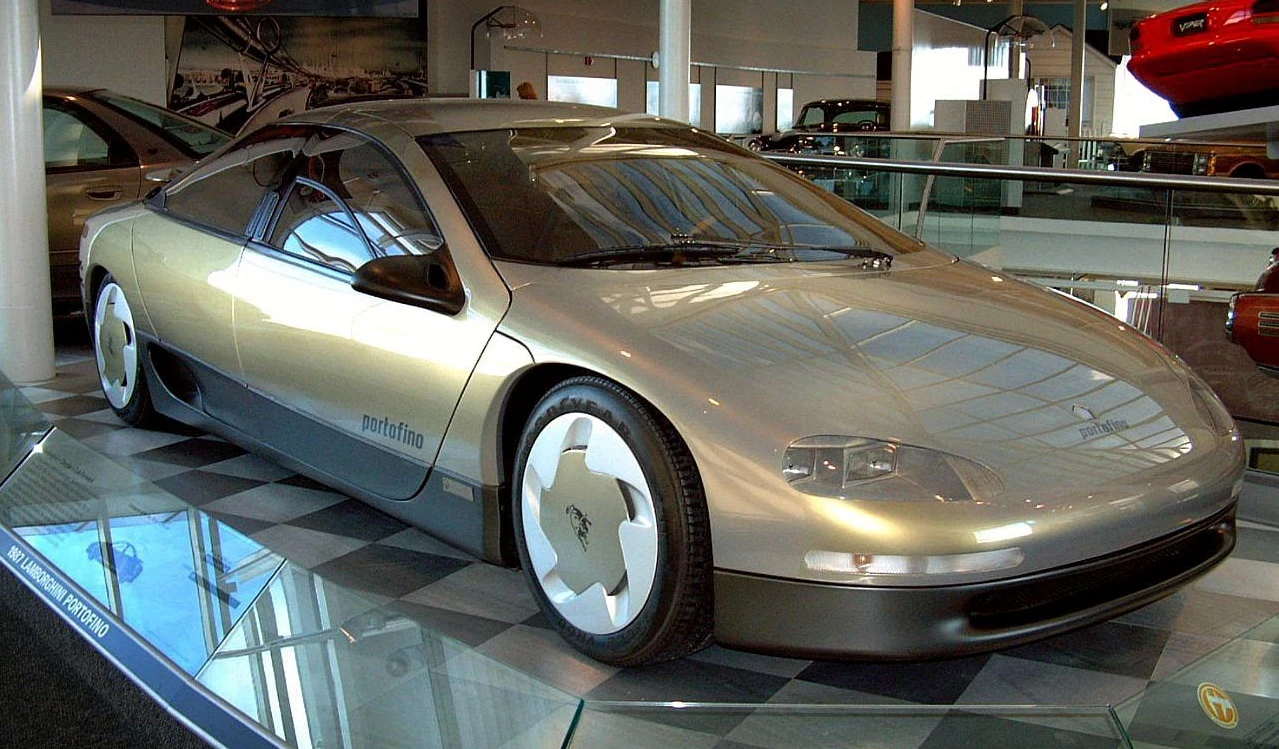
The 1983 Chrysler Lamborghini Portofino’s exterior represented a revolutionary approach to supercar design with its four-door configuration while maintaining dramatic proportions. Marcello Gandini’s design featured characteristic sharp edges and aggressive angles that maintained Lamborghini’s design language while expanding functionality. Its most distinctive elements were the four scissor doors that opened upward in signature Lamborghini fashion, providing dramatic access to both front and rear seating positions – an unprecedented feature in supercar design. The front incorporated aggressive air intakes and rectangular headlights characteristic of contemporary Lamborghini models, while the rear featured horizontal taillights spanning the width of the vehicle.
1983 Chrysler Lamborghini Portofino (Interior)
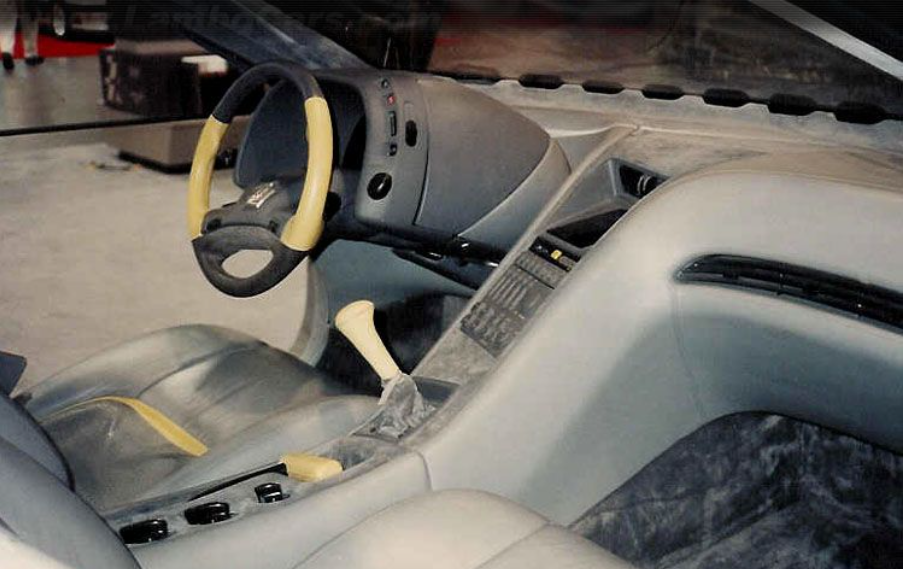
Inside the Portofino, designers created a genuine four-passenger supercar environment that maintained Lamborghini’s performance focus while adding unprecedented practicality. The dashboard featured a driver-oriented design with comprehensive instrumentation angled toward the operator position and a center console that extended the full length of the cabin, dividing the interior into four distinct seating areas. Each position featured a bucket seat with bolstering appropriate for high-performance driving, upholstered in premium leather with contrasting stitching. The rear seats offered legroom comparable to luxury sedans – exceptional for a vehicle with supercar styling and proportions. Aircraft-inspired toggle switches controlled secondary functions, while primary controls maintained proper ergonomics for performance driving.
8. 1986 Chevrolet Corvette Indy Concept (Exterior)
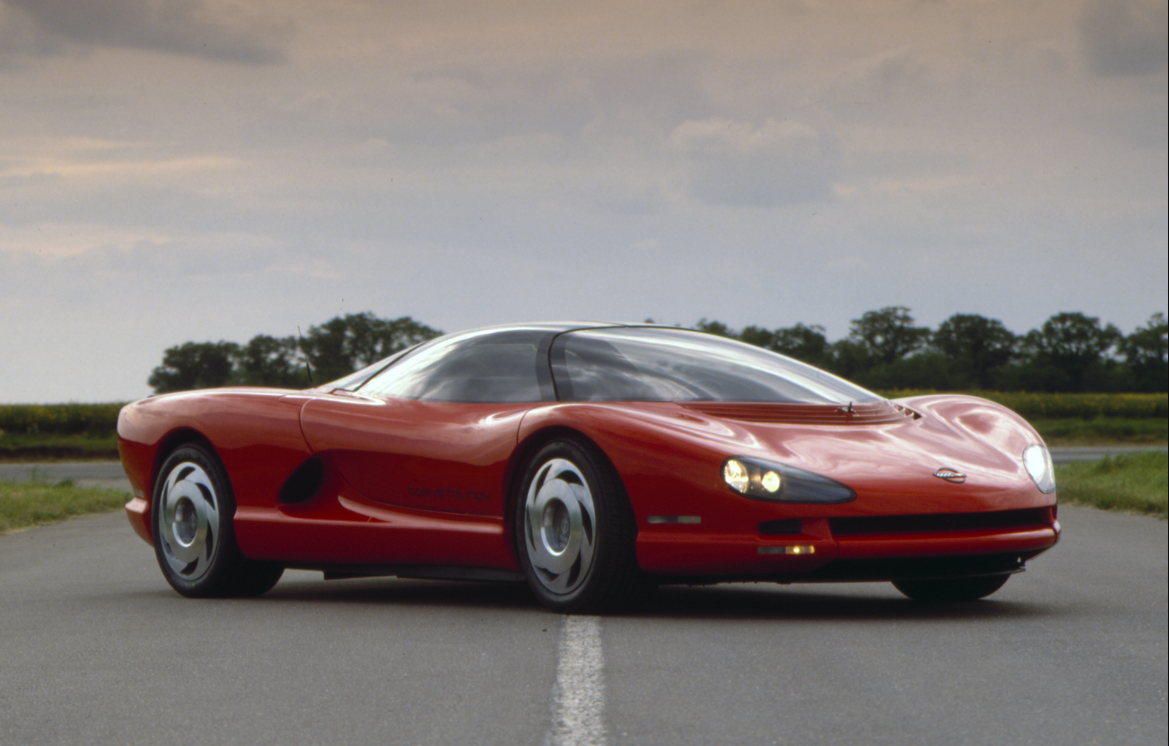
The 1986 Chevrolet Corvette Indy concept’s exterior represented a complete reimagining of America’s sports car with a purpose-built mid-engine design constructed from advanced materials. Its low, wide stance featured dramatically sculpted air intakes feeding the centrally mounted engine, while the front incorporated slim, horizontal headlights that would influence later Corvette models. The body, crafted from Kevlar and carbon fiber components, featured flying buttress elements connecting the roof to dramatically flared rear fenders. The greenhouse incorporated a fighter jet-inspired canopy with extensive glass surfaces improving visibility while maintaining aerodynamic efficiency.
1986 Chevrolet Corvette Indy Concept (Interior)
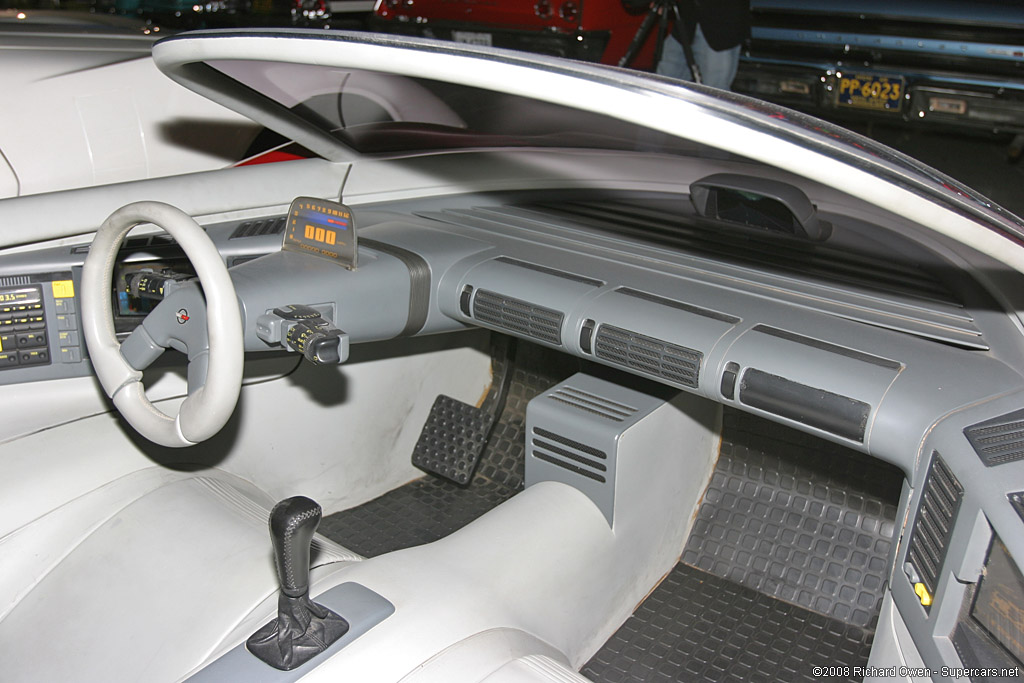
The Indy concept’s interior balanced experimental technology with practical performance car ergonomics to create a driver-focused environment. The dashboard incorporated a comprehensive digital display system showing vehicle information through early LCD screens – advanced technology for 1986. The steering wheel featured a small-diameter, leather-wrapped rim with a flattened bottom section, improving ingress/egress, while the center console housed a manual shifter controlling the experimental transaxle. Most innovative was the early satellite navigation system that displayed mapping information on the central screen – technology that wouldn’t become common in production vehicles for another decade. Climate controls utilized touch-sensitive interfaces rather than conventional knobs and buttons, contributing to the concept’s futuristic appearance while demonstrating GM’s interface design capabilities.
7. 1988 Pontiac Banshee (Exterior)
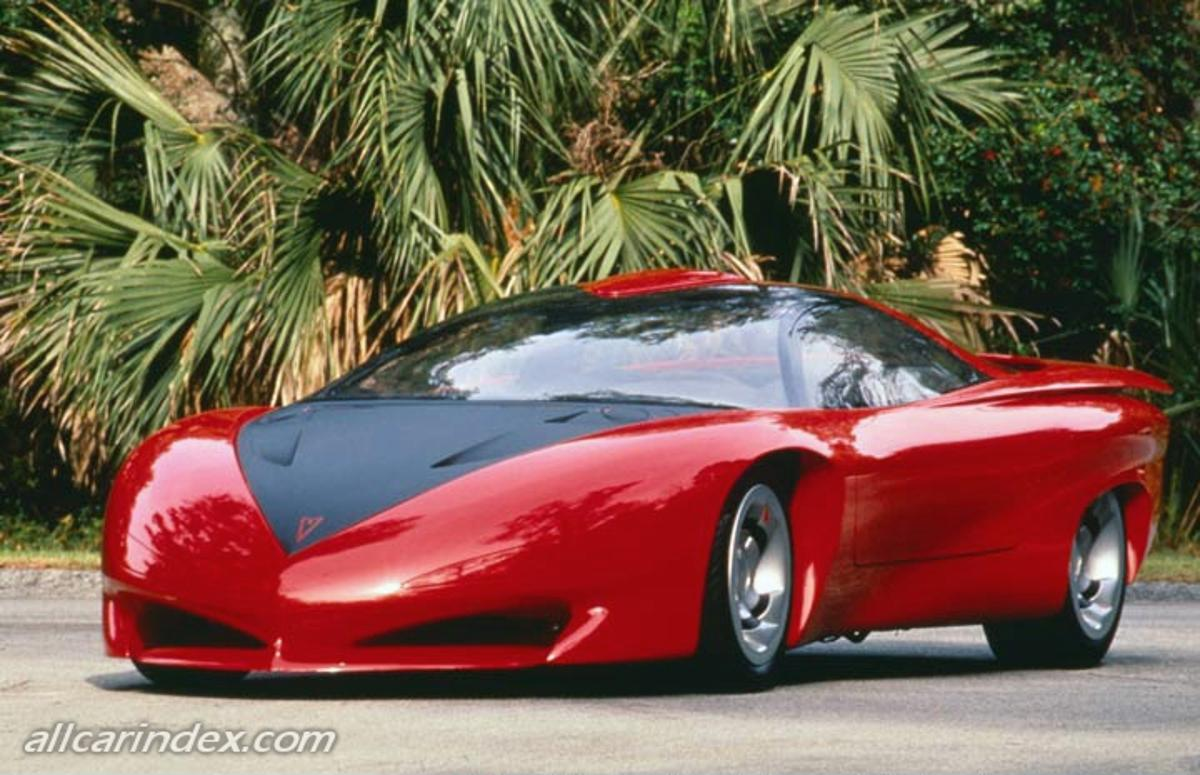
The 1988 Pontiac Banshee’s exterior signaled a dramatic shift in American performance car styling with smooth, rounded forms replacing the sharp angles that had dominated muscle car design. Its aerodynamic profile featured flush headlights, a steeply raked windshield, and integrated bumpers that created visual continuity throughout the body. The front incorporated slim lighting elements and cooling intakes integrated into a smooth fascia that minimized drag while maintaining visual aggression appropriate for a performance model. The greenhouse featured a dramatic wraparound glass treatment creating a cockpit-like appearance, while the rear incorporated an integrated spoiler and horizontal taillights that would directly influence the production Firebird.
1988 Pontiac Banshee (Interior)

Inside the Banshee, Pontiac created a driver-focused environment that previewed the next generation of American performance car interiors. The dashboard wrapped around the driver position with a comprehensive instrument panel featuring analog gauges set into deep pods for excellent visibility under various lighting conditions. Seating consisted of heavily bolstered sport buckets with integrated headrests, providing lateral support during enthusiastic driving while maintaining reasonable comfort for longer journeys. The steering wheel featured a leather-wrapped rim with thumb detents and a small-diameter design optimized for quick inputs. Most forward-thinking was the integrated driver information center displaying vehicle status and performance metrics through an early LCD screen – technology that would later become standard in production performance models.
6. 1987 Chevrolet Express (Exterior)
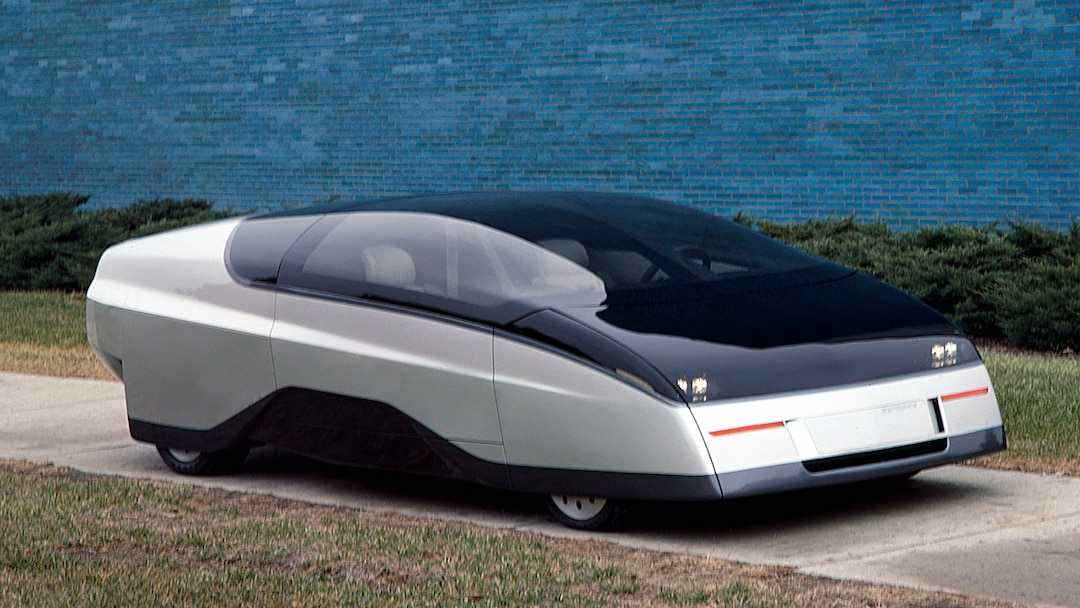
The 1987 Chevrolet Express’s exterior represented perhaps the most radical departure from conventional automotive design among GM’s concepts with its pod-like shape crafted entirely from carbon fiber – extraordinary for the period. Its smooth, aerodynamic profile featured minimal openings and surface interruptions, optimizing airflow around the vehicle while creating a distinctly futuristic appearance. The greenhouse consisted of a large, panoramic canopy providing exceptional visibility while maintaining the concept’s streamlined form. Its most dramatic element was the vertically opening roof section that lifted upward for entry and exit rather than using conventional doors.
1987 Chevrolet Express (Interior)
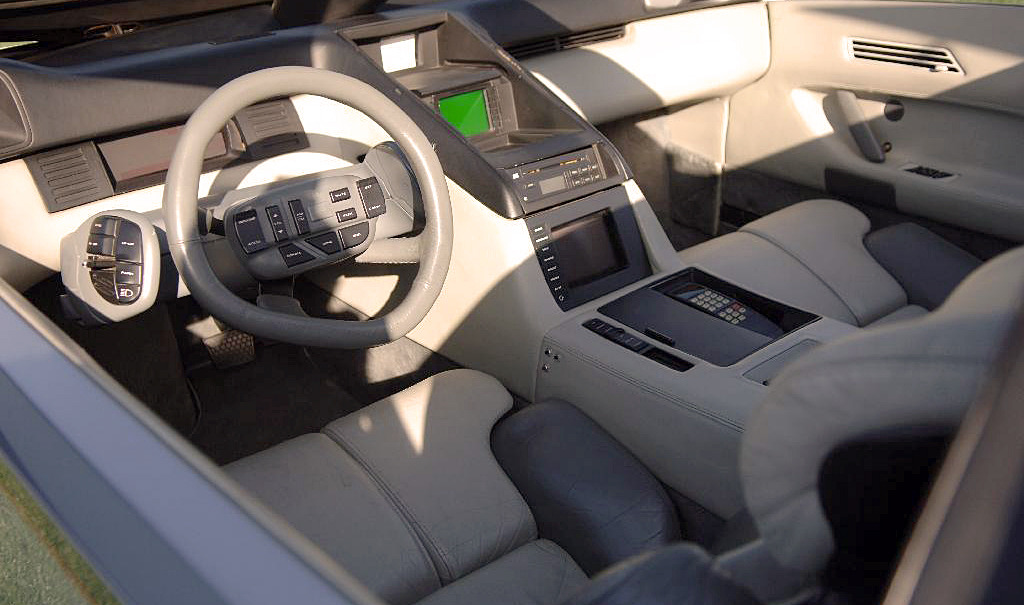
The Express’s interior matched its exterior’s futuristic approach with a comprehensive reconceptualization of the automotive passenger environment. Seating consisted of four individual bucket seats arranged in a lounge-like configuration rather than the conventional forward-facing arrangement. The dashboard eliminated traditional instrumentation in favor of a comprehensive digital interface displaying vehicle information through multiple screens positioned for optimal visibility. Drive-by-wire controls replaced conventional mechanical linkages, allowing engineers to position the steering mechanism and pedals optimally without traditional constraints. Interior lighting utilized early LED technology creating configurable ambient effects throughout the cabin – advanced technology for 1987.
5. 1987 Chevrolet Blazer XT-1 (Exterior)
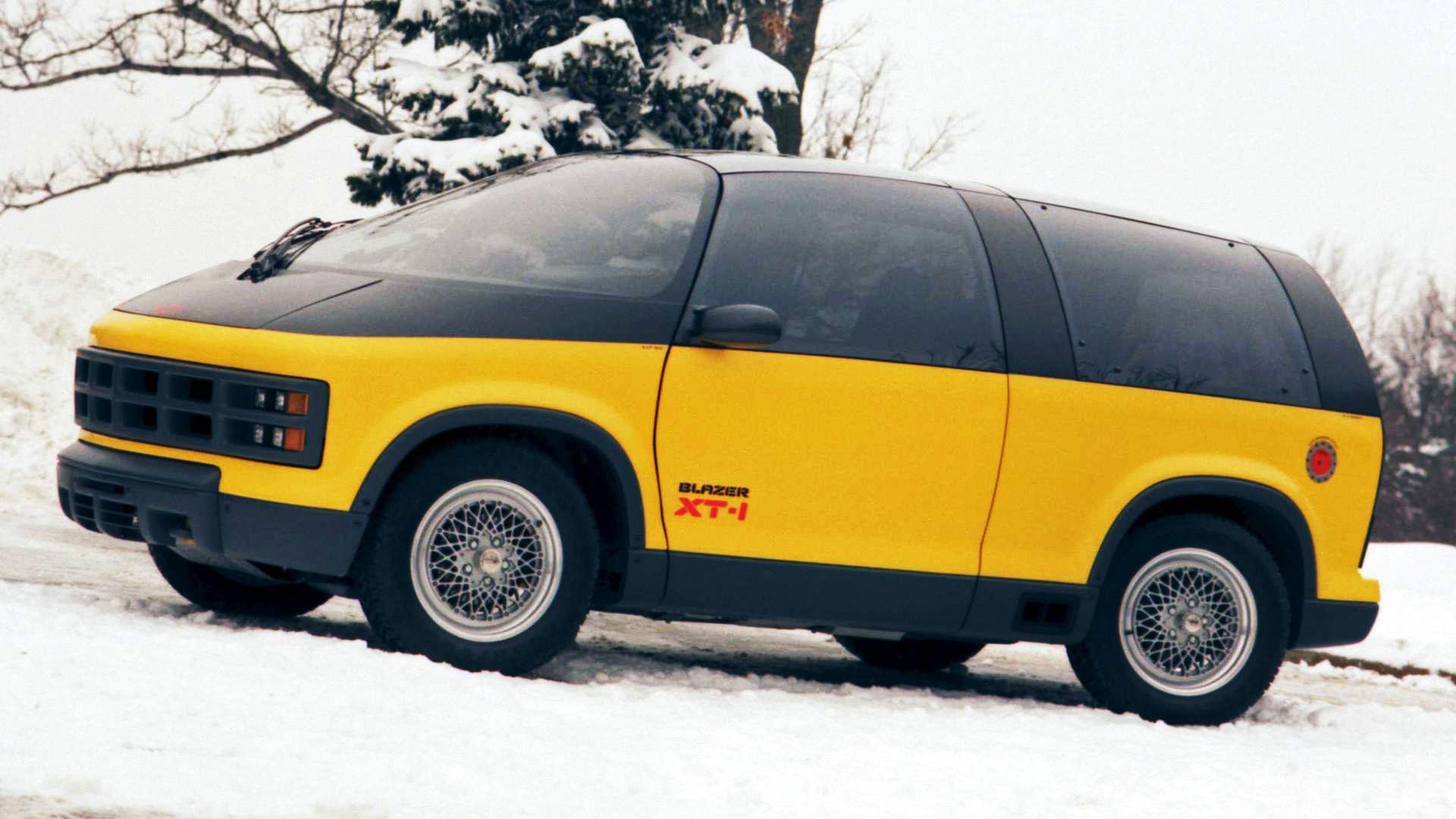
The 1987 Chevrolet Blazer XT-1 redefined expectations for SUVs through forward-thinking technology and versatile features. Its two-tone body treatment featured a distinctive character line separating the upper and lower sections, creating visual tension while referencing traditional off-road vehicles with protective lower cladding. Its most innovative feature was the retractable roof system that could transform the vehicle from enclosed SUV to open-air recreational vehicle. The greenhouse featured expansive glass areas including an extended sunroof, enhancing the interior experience regardless of configuration. Wheel arches featured pronounced flares accommodating the substantial off-road tires while emphasizing the concept’s capability.
1987 Chevrolet Blazer XT-1 (Interior)
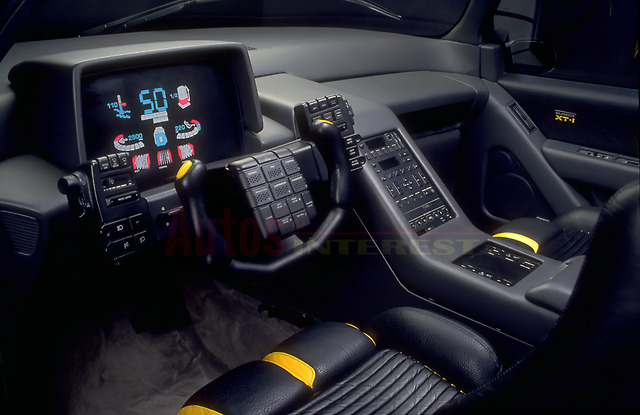
Inside the Blazer XT-1, Chevrolet created a technology-focused environment that balanced innovation with practical off-road functionality. The dashboard featured a revolutionary digital display system replacing conventional analog gauges with early LCD screens showing vehicle information in a configurable format. The center console incorporated terrain management controls allowing drivers to optimize vehicle systems for various conditions, an early implementation of technology that would later become common in production SUVs. The steering wheel incorporated an asymmetrical design with a thickened rim providing secure grip during technical off-road maneuvers.
4. 1984 Dodge M4S Turbo Interceptor (Exterior)

The 1984 Dodge M4S Turbo Interceptor’s exterior combined dramatic supercar styling with functional aerodynamic elements resulting in a design distinctive enough to star in a Hollywood film. Its wedge-shaped profile featured a dramatically low hood line leading to a steeply raked windshield, creating a continuous visual plane that enhanced aerodynamic performance. The side profile incorporated aggressive flying buttress C-pillars channeling air to the rear of the vehicle while creating a distinctive silhouette unlike anything in Chrysler’s production lineup. The front featured retractable headlights maintaining a clean appearance when not in use, while the rear incorporated horizontal taillights spanning the width of the vehicle.
1984 Dodge M4S Turbo Interceptor (Interior)
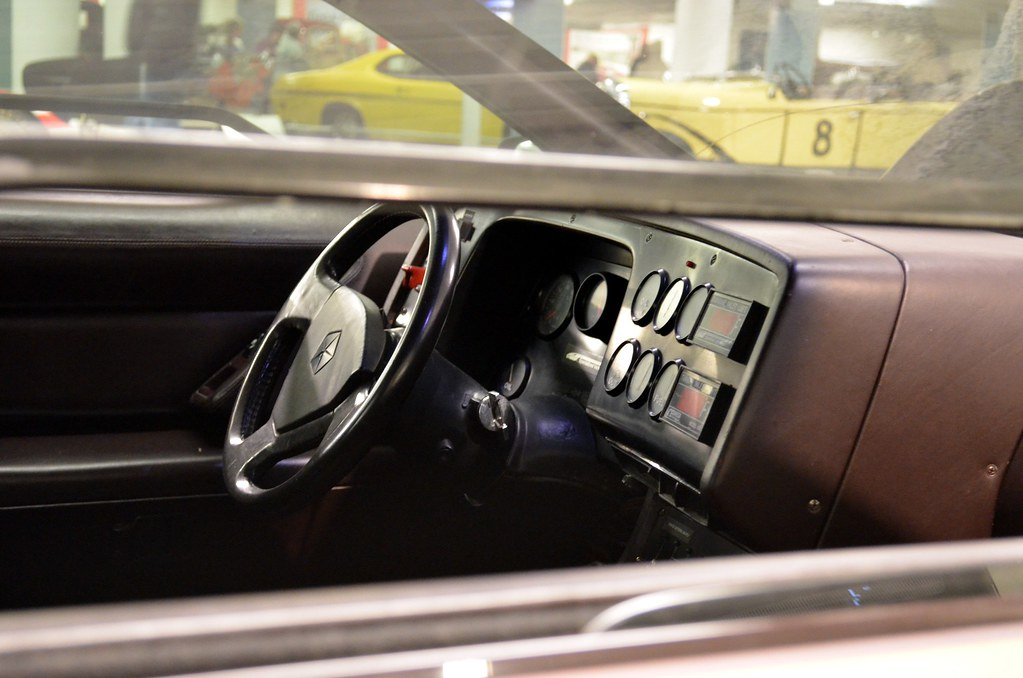
The M4S featured a driver-focused interior that prioritized performance with a central seating position flanked by passenger seats set slightly rearward – an unusual three-across configuration reminiscent of the McLaren F1 that would appear years later. The dashboard wrapped around the driver position with comprehensive instrumentation angled for optimal visibility during high-speed driving. The center console housed the shifter controlling the manual transmission along with essential secondary controls positioned within easy reach. Interior surfaces featured a combination of leather and technical fabrics in dark tones that minimized reflections on the windshield – a practical consideration for a high-performance vehicle designed to achieve substantial speeds.
3. 1984 Honda HP-X (Exterior)

The 1984 Honda HP-X’s exterior established design principles that would later define the production NSX with clean, functional surfaces guided by aerodynamic performance rather than stylistic excess. Its low, wide stance featured carefully optimized proportions with the cabin positioned forward to accommodate the mid-mounted engine. The front incorporated slim headlights and minimal air intakes reflecting the concept’s focus on aerodynamic efficiency, while the profile revealed flying buttress elements channeling air along the body sides to the rear of the vehicle. The greenhouse featured a distinctive black canopy contrasting with the body color while optimizing outward visibility – a design element that would directly influence the production NSX.
1984 Honda HP-X (Interior)
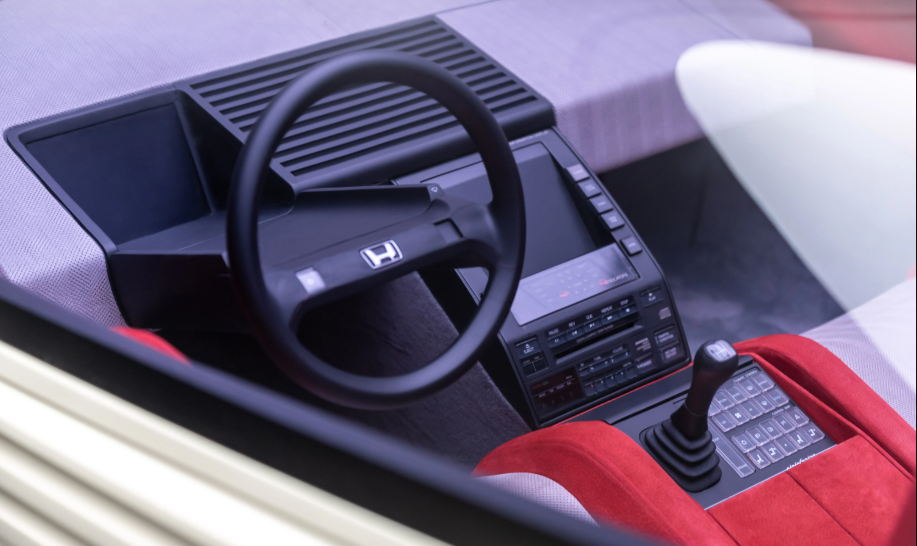
Inside the HP-X, Honda prioritized driver engagement with a cockpit designed around human factors and control accessibility. The dashboard featured a comprehensive instrument panel with analog gauges set into deep housings preventing glare under various lighting conditions. Seating consisted of supportive bucket seats positioned low in the chassis, creating a competition-inspired driving position that would become a signature element of the production NSX. The steering wheel featured a small-diameter design with a leather-wrapped rim optimized for performance driving, while pedals were perfectly positioned for heel-and-toe downshifting – a detail reflecting Honda’s focus on driver engagement.
2. 1984 Ford Probe IV (Exterior)

The 1984 Ford Probe IV’s exterior represented the ultimate expression of aerodynamic efficiency with every surface optimized to minimize drag. Its teardrop profile featured an extended tail section that gradually tapered to reduce turbulence, while the front incorporated minimal openings providing only essential cooling. The greenhouse featured flush glass surfaces with minimal seams, while the entire body eliminated unnecessary protrusions that might disturb airflow. These comprehensive optimizations resulted in an astonishing 0.152 drag coefficient – a figure that remains impressive even by modern standards and demonstrated Ford’s aerodynamic engineering capabilities.
1984 Ford Probe IV (Interior)
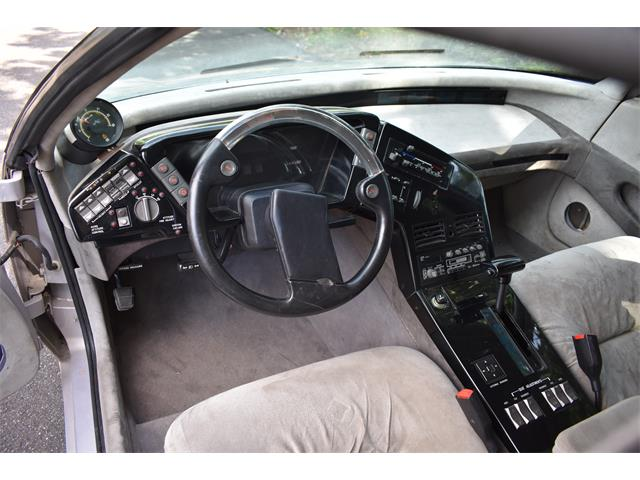
The Probe IV’s interior balanced experimental aerodynamic research with practical human factors to create a functional driver environment. The dashboard incorporated a comprehensive digital interface displaying vehicle information in a clean, modern format that minimized visual clutter. The steering wheel featured an oval shape optimized for visibility of the instrument display while maintaining control during maneuvers. Window controls and secondary functions were integrated into the center console, maintaining the clean interior design philosophy while remaining accessible to occupants. The interior color palette consisted primarily of neutral tones that minimized distractions, allowing test drivers to focus on evaluating the concept’s aerodynamic performance.
1. 1983 Mazda MX-02 (Exterior)
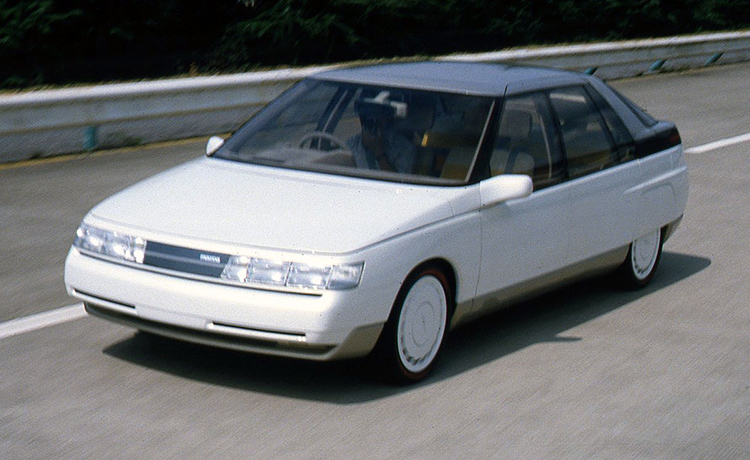
The 1983 Mazda MX-02’s exterior prioritized urban functionality with compact dimensions and efficient packaging that maximized interior space. Its wedge-shaped profile featured a short hood leading to an expansive greenhouse providing excellent visibility for navigating crowded city streets. The front incorporated slim headlights and a minimal grille opening reflecting the concept’s focus on aerodynamic efficiency, while the rear featured a practical hatchback design enhancing cargo versatility. Body surfaces featured crisp edges and geometric shapes characteristic of early 1980s design language, balanced with functional considerations appropriate for an urban-focused vehicle.
1983 Mazda MX-02 (Interior)
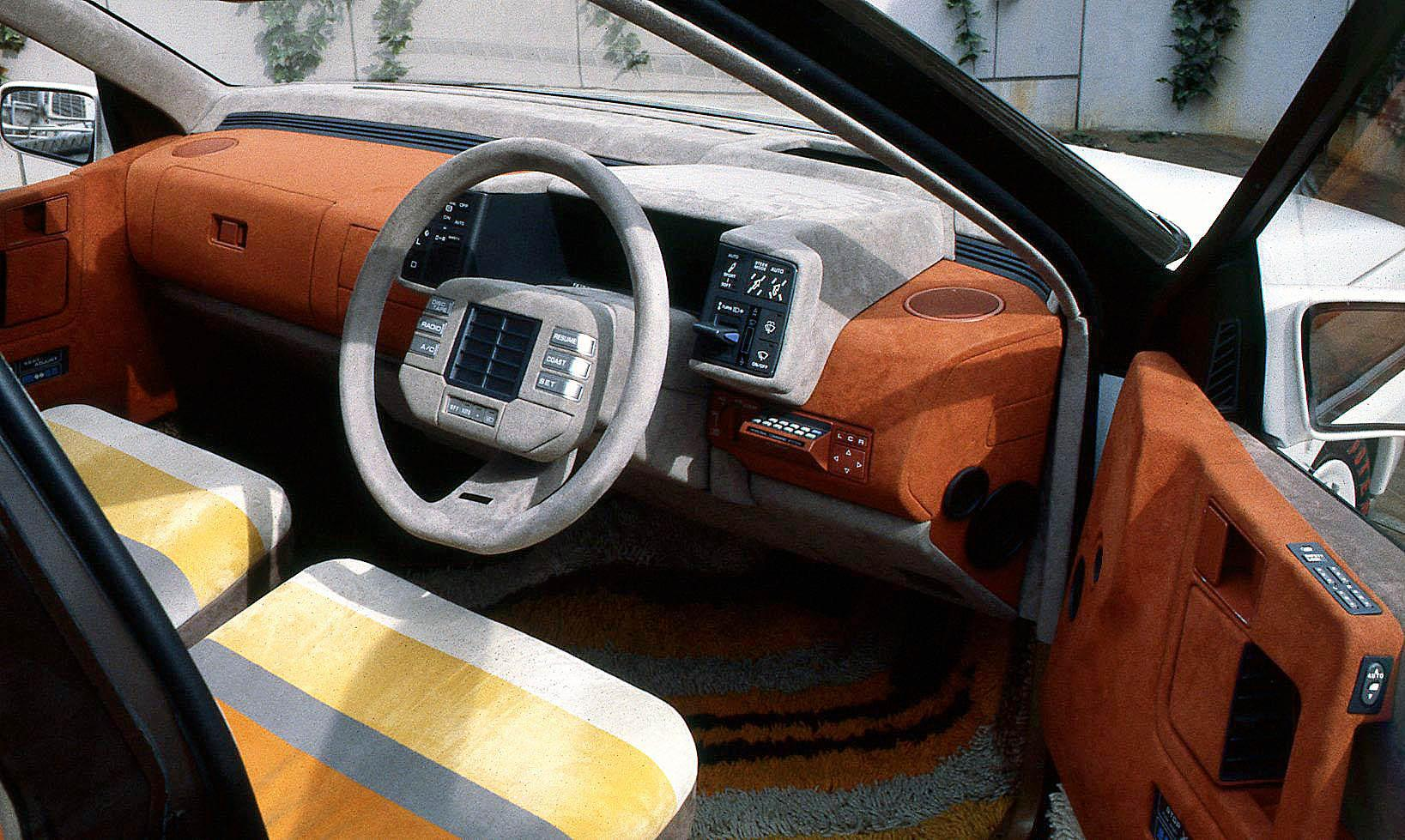
Inside the MX-02, Mazda created a technology-focused environment that anticipated future interface design with a comprehensive digital control system. Seating featured space-efficient bucket designs that maintained comfort while maximizing interior room within the concept’s compact exterior dimensions. The steering wheel incorporated an asymmetrical design with a flattened lower section improving ingress/egress – a practical consideration for a vehicle designed for frequent urban use. The center console housed a joystick-like controller managing the revolutionary four-wheel steering system, allowing drivers to optimize vehicle maneuverability for various urban environments.














